🔙 Main LCC11 page
PDF schedule
Venue photos
See venue photos, map, and PDF schedules here.
See also the maps on the LCC11 resources page.
Start times
- Friday: 09:00 social, 14:00 programming
- Sat & Sun: 07:30
Index
Venue codes:
- J (Jiménez, Friday only): Jiménez Hall, room 1205 (Loretta Clough Community Room)
- G (Garage, primary): H.J. Patterson building, combined rooms 2124 (“Garage”) and 2113 (“Hub”)
- S (secondary): HJP combined rooms 2114 and 2118
- T (tertiary): HJP room 2123 (Language Science Center meeting room)
- A (atrium): HJP atrium, “rooms” 1125 & 1198
- U (union): Adele H. Stamp Student Union
Status codes:
- + plenary
- P poster
- I in person
- R remote
- IR combined in person & remote
Presentations
| time | presenter(s) | title | abstract | bio(s) | |
|---|---|---|---|---|---|
| Sat 13:40 G+ I | Erin Moriarty Harrelson | Natural Language or Linguistic Technoscience? Signed languages as sites of creation, negotiation and adaption | Signed languages are sites of creation, negotiation, and adaptation. This presentation explores the historical trajectory of Cambodian Sign Language, examining its ongoing development and the unique metalinguistic engagement of signing communities with sign languages in general. From the calibration involved in the use of International Sign (IS) to the intentional modifications of American Sign Language (ASL) to remove English influences and the technoscientific invention of visual systems to represent English (and other spoken languages), deaf educators and signers have played an active role in shaping their linguistic landscapes.
I also examine the theoretical debates about the classification of signed languages. Drawing on my ethnographic findings in Cambodia and Indonesia, including the complex sociolinguistic dynamics of Cambodian signed languages, this talk highlights the interplay between linguistic agency, community collaboration, and the intentional design of visual communication systems. By weaving together historical analysis, contemporary case studies, and theoretical insights, this presentation illuminates the intersection of linguistic evolution and deliberate linguistic and technoscientific interventions in signed languages. |
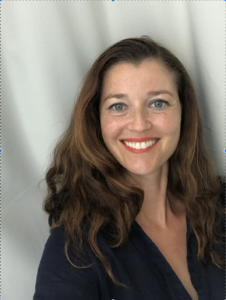 Dr. Erin Moriarty Harrelson is a Deaf linguist and Assistant Professor of Anthropology and American Sign Language Program at the University of Virginia. Dr. Erin Moriarty Harrelson is a Deaf linguist and Assistant Professor of Anthropology and American Sign Language Program at the University of Virginia.
An ethnographer with extensive fieldwork experience in Cambodia and Indonesia, Erin Moriarty researches the intersection of mobility and languaging practices, focusing on deaf linguistic practices in transnational settings as they shape and are shaped by language ideologies. Her work examines language use, translanguaging, sign language documentation, and the socio-cultural dynamics within deaf communities. Moriarty’s scholarly contributions include the recent co-edited volume, “Deaf Mobility Studies,” published by Gallaudet Press in July 2024. Notable articles include “Deaf Cosmopolitanism: Calibrating as a Moral Process” (with Annelies Kusters), “Filmmaking in a Linguistic Ethnography of Deaf Tourist Encounters“, and “‘Sign to me, not the children’: Ideologies of language contamination at a deaf tourist site in Bali“. Additionally, she has produced an ethnographic film, “#DeafTravel: Deaf Tourism in Bali“. Her research has been supported by fellowships and awards, including a Fulbright-National Geographic Digital Storytelling Fellowship and a recent award from the NEH to reimagine Deaf Studies for the future. One of her notable projects was funded by the Fulbright-National Geographic Digital Storytelling Fellowship, where she spent a year documenting the experiences of deaf Cambodians. Moriarty’s dissertation explores the emergence of a deaf community in post-Khmer Rouge Cambodia, the documentation of Cambodian Sign Language by NGOs and community languaging practices. Moriarty recently concluded her work with the MobileDeaf research team at Heriot-Watt University, a 5-year European Research Council-funded project. Moriarty earned her Ph.D. in Anthropology from American University, her M.A. in Communications in Contemporary Society from Johns Hopkins University and a B.A. in Art History and Anthropology from Smith College. She has held a post-doctoral appointment at Heriot-Watt University in Edinburgh, Scotland. She is now Assistant Professor in Anthropology at the University of Virginia. |
|
| Sun 09:00 G+ I | Sheri Wells-Jensen | Eyes-Free Orthography: braille and its historic other options | Braille is not a language; rather, it is a toolkit for constructing tactile orthographies for languages (as well as for music notation and mathematics) — useful for blind people and for anyone else who wishes to read and write eyes-free.
The basic orthographic unit is the cell, a 2×3 matrix of dots typically embossed on heavyweight paper. The height, size, and spacing of the dots within each cell are prescribed so that each cell fits neatly under a fingertip. This makes it possible to scan a line quickly from left to right, but also means that there are no font choices for braille, as there are for print orthographies. English braille comprises a tactile version of the Roman alphabet, a subset of English morphemes, some lexical items, frequently-occurring letter combinations, and a set of rules for their use. Along with a quick overview of modern braille and some recent changes to the system, we will explore tactile orthographic systems that preceded and shaped braille, including Charles Barbier’s 1815 dot system, sometimes called “Night Writing”, William Moon’s 1845 “Moon Type”, 1880 “New York Point”, and 1900 “American” Braille. If time permits, we will also explore a recently-proposed tactile system to facilitate wayfinding aboard spacecraft in a zero-G environment. Thanks to my hard-working grad student Julia Evangelista for helping to make this presentation. |
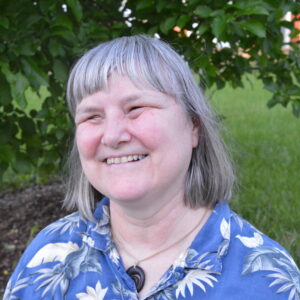 Dr. Sheri Wells-Jensen is a blind professor of Linguistics at Bowling Green State University in Bowling Green, Ohio, USA where she directs the linguistics minor and the English for Speakers of Other Languages program. She was the Library of Congress / NASA 2023 Baruch S. Blumberg Chair in Astrobiology, Exploration and Scientific Innovation, and currently works with the Library of Congress National Library Service for the Blind and Print Disabled on innovation in tactile graphics design. Her research focuses on braille literacy, human factors in space exploration, and disability and space. She is the author of Ragayo, a language spoken by hyper intelligent bears for Scholastic Book’s BearHaven Series. She is dedicated to making outer space accessible to all humanity. Dr. Sheri Wells-Jensen is a blind professor of Linguistics at Bowling Green State University in Bowling Green, Ohio, USA where she directs the linguistics minor and the English for Speakers of Other Languages program. She was the Library of Congress / NASA 2023 Baruch S. Blumberg Chair in Astrobiology, Exploration and Scientific Innovation, and currently works with the Library of Congress National Library Service for the Blind and Print Disabled on innovation in tactile graphics design. Her research focuses on braille literacy, human factors in space exploration, and disability and space. She is the author of Ragayo, a language spoken by hyper intelligent bears for Scholastic Book’s BearHaven Series. She is dedicated to making outer space accessible to all humanity. |
|
| Fri 15:10 J+ I | John H.G. Scott | (De)Constructing Culture through Constructed Languages: U-Boots in Space, Decolonizing our Fantasies, and Transgressing Taboo on Naboo | Since the rise of American structuralism in the early 20th century, language and culture have often been severed and studied in isolation, entertaining the fiction that they can be investigated as discrete phenomena. The effect of this division has profound impacts. These include, but are not limited to, institutional divisions that distance the study of language (linguistics and language acquisition) from the study of world literatures and cultures (language programs) at most North American universities, as well as decreased proportions of language-program faculty who specialize in the linguistic study of a language or language family in recent decades. Despite this divide, scholars of linguistics (e.g., Jakobson, 1985), anthropology (e.g., Agar, 1994), and philosophy (Badiou, 1999) remind us that study of culture, philosophy, and the structural and functional study of language cannot and should not be fully separated this way. Conlangs (i.e., constructed languages) intersect all of these ways of knowing. Although often overlooked or poorly understood, conlangs and conlanging offer potential insights to all of these fields (e.g., Adams, 2011; Everett, 2013; Okrent, 2009). In this introduction to conlanging in cultural historical context, the creator of Baldung, the Germanic-inspired conlang spoken in the Netflix series Archive 81, delivers a crash course in conlangs in terms of typology, creator motivations, historical contexts, emergence in modern media, and educational value.
References
|
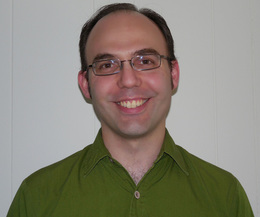 John started conlanging as a teenager with Küyüki, a D&D naming language, which he expanded as he learned about linguistics for his BA. During graduate school, he led a team of volunteer creatives to produce the a posteriori Stygian conlang for a multinational LARP game called Space: The Infinite Edge, and he taught an undergraduate course on conlangs at Indiana University in 2015 and 2017. After earning his PhD in Second Language Studies in 2019, he was tapped by the Netflix Original show Archive 81 to create the Baldung language, an a posteriori artlang descendant of Old Saxon. He is currently working on five artlang projects, including documenting the Antichthonian, Nwâfzjùúl, and Paranthropic languages, co-creating the Pelarkast language, and using the Nejtiesie language as a training tool for the next generation of foreign language teachers. John started conlanging as a teenager with Küyüki, a D&D naming language, which he expanded as he learned about linguistics for his BA. During graduate school, he led a team of volunteer creatives to produce the a posteriori Stygian conlang for a multinational LARP game called Space: The Infinite Edge, and he taught an undergraduate course on conlangs at Indiana University in 2015 and 2017. After earning his PhD in Second Language Studies in 2019, he was tapped by the Netflix Original show Archive 81 to create the Baldung language, an a posteriori artlang descendant of Old Saxon. He is currently working on five artlang projects, including documenting the Antichthonian, Nwâfzjùúl, and Paranthropic languages, co-creating the Pelarkast language, and using the Nejtiesie language as a training tool for the next generation of foreign language teachers. |
|
| Sat 10:35 G+ R Sat 17:30 G+ R |
Alice jan Olipija |
Basics of Sign Languages for Conlangers | Sign languages build grammar differently from spoken languages, owing to their existence in physical space. In particular, sign languages make use of features like iconicity, extensive classifier constructions, and constructions dependent on space. For those looking to start a signed conlang project, particularly a naturalistic one, it can seem daunting to learn how these different worlds of grammar work. This presentation will build an understanding of the ways various sign languages build nouns iconically, how elements of sign grammar can be used, how features like classifiers and space interact, the 3 types of verbs found in sign languages, and how these features can be implemented into a conlang.
jan Olipija will present on how nouns are constructed using iconicity, as well as how classifiers are used depictively and their productive role in sign languages. For nouns, sign languages – especially young sign languages, tend to evolve nouns out of iconicity – mirroring the visible world. In this section, the audience will be encouraged to imagine the creation of a new noun via the lexicalisation of an iconic gesture. For classifiers – they can be broken down into Semantic, SASS, Instrument, Bodypart and Body – and the audience will be encouraged to think about how these can be formed using the phonology of a consignlanguage. Alice will then present about the use of space in sign languages, starting with a description of the 3 types of verbs in sign languages (plain, agreeing, and locative). Next, the basics of space will be covered. Space can be used for spatial and temporal relations, to mark verb agreement, to indicate nouns, and to describe actions and physical properties. These constructions can operate on both a grammatical level, having consistent meanings; and a discourse level, varying depending on context. Then there will be a discussion of some of the major differences between urban and village sign languages. Generally, urban sign languages are similar to each other in their ample use of classifiers and spatial constructions, while village sign languages vary more from each other while still tending towards less classifiers and spatial constructions. After a summary of the major points of iconicity, classifiers, signspace use, and variations between urban and village sign languages; these ideas will be demonstrated in the context of a conlang through a case study of one of Alice’s signed conlang projects, called “Mangrove Sign Language.” Presenters will show how it began as a village sign language, and how that informed its use of space, verbs, and classifiers. Then, the audience will be asked to consider ways its use of classifiers and space could evolve as it urbanizes. The presentation then concludes with a summary of steps and considerations, and with recommendations of sources for further reading. Signspace references
Nouns & Iconicity references
Classifiers and Production references
|
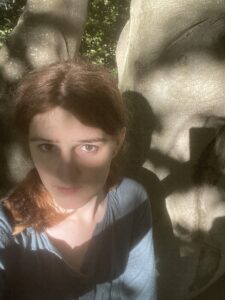 Alice is a 20 year old university student studying speech-language pathology, and hard of hearing (SSD) learner of ASL. She has been conlanging for a decade, and while she tends to focus on naturalism, she also has limited experience with languages like Lojban and toki pona. Feel free to shoot her a friend request on Discord @green.emerald ! Alice is a 20 year old university student studying speech-language pathology, and hard of hearing (SSD) learner of ASL. She has been conlanging for a decade, and while she tends to focus on naturalism, she also has limited experience with languages like Lojban and toki pona. Feel free to shoot her a friend request on Discord @green.emerald !
jan Olipija is a hard of hearing signer of BSL. She works as a Freelance Language Consultant and also in a role with Deaf adults. She has a BA(Hons) in BSL, Deaf Studies and Linguistics. |
|
| Sat 11:40 G+ I | Zie Weaver | Survey of Logical Languages | Loglangs, or logical languages are under-represented and occasionally disparaged within the conlanging community. In order to demystify these intriguing languages, we start by attempting a definition and cover their history, inner workings, and notable examples including Loglan, Lojban, and Toaq. We will also illuminate some obscure though influential loglangs not commonly discussed in the broader community. While on the topic of community, we will quickly review a modern history of loglanging and notable accomplishments, events, schisms, and communities.
The second half will provide a survey of the technical workings of logical language. This includes defining jargon like SSM, logical form, abstractions, and terminators; and exploring perspectives like what it means for a language to be “unambiguous”. We will also discuss some unique lexicographic concerns, i.e. what are the consequences of defining in terms of predicates instead of as other parts of speech. Finally we conclude with the recent cutting edge explorations of formal semantics and some unexplored opportunities for future conlangs. If one is curious about attending talks on the loglang track, but are unfamiliar with these captivating languages and their construction, this talk is a great first step and will cover most of what one needs to know to follow these specialist talks. If one would like more detail on the implementation of the topics discussed here, consider attending Introduction to Loglanging. |
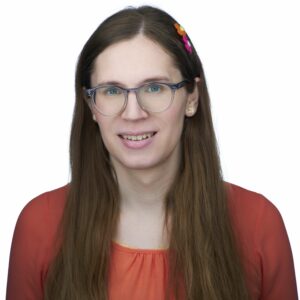 Zie Weaver is a professional software engineer specializing in large scale refactoring by day and a loglang enthusiast by night. She has studied Lojban for almost two decades and is one of the few conversational speakers. Her interests have blossomed far beyond this language alone, and has studied loglangs generally for five years (and is developing a few of her own). Zie Weaver is a professional software engineer specializing in large scale refactoring by day and a loglang enthusiast by night. She has studied Lojban for almost two decades and is one of the few conversational speakers. Her interests have blossomed far beyond this language alone, and has studied loglangs generally for five years (and is developing a few of her own).
Discord: @zearen |
|
| Sat 18:00 A+ I | Riddlesbrood | Sherlock Holmes and the ‘Power’ of Babble – A Murder Mystery of Deadly Secrets, Devious Codes, and Delightful Nonsense! | The year is 1899, and the world teeters on the brink of chaos! A series of assassinations has left the great powers of Europe in turmoil, and the only clue linking these crimes is a baffling collection of coded messages, each written in a completely unique, unknown language. Scotland Yard is utterly stumped. The cryptographers at Oxford are scratching their powdered heads. Even the Queen’s royal linguists are at a loss! The fiends behind this dastardly plot are none other than the Illumi-Naughty—a shadowy, possibly fictional organization whispered about in only the most paranoid of circles. Are they real? Or just the invention of madmen and conspiracy theorists? One thing is certain: someone is pulling the strings, and unless the secret of the Power of Babble is unraveled, the assassins will strike again!
With no hope left, the authorities turn to the brilliant, albeit peculiar, Sherlock Holmes, but even he cannot solve this alone! That’s where YOU come in! For only the Conlangers of the world can help crack the case! This comedic, audience-driven murder mystery will have you:
With plenty of laughs, audience participation, and thrilling twists, Sherlock Holmes and the Power of Babble is the perfect evening for conlang enthusiasts, puzzle-solvers, and lovers of Victorian absurdity! But beware—every word matters, and a single mistranslation could spell your doom! So, ready your wits, polish your monocles, and prepare to crack the case before it’s too late! After all, in the world of mystery and murder, the only thing more dangerous than a secret… is a secret you can’t understand! |
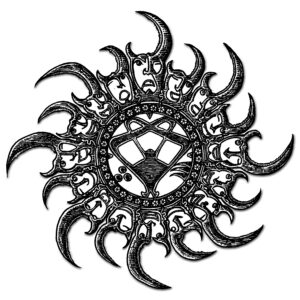 Riddlesbrood Touring Theater Company Riddlesbrood Touring Theater Company – 25 Years of Theatrical Magic and Linguistic Mystery!Since its founding in 2000, Riddlesbrood Touring Theater Company has been an ever-wandering troupe of storytellers, actors, and dream-weavers, bringing thousands upon thousands of performances to audiences across New Jersey, Pennsylvania, New York, Delaware, Maryland, and beyond. Now in our 25th anniversary year, we remain dedicated to our mission: to re-enchant the world through imagination, improvisation, and humor! A key element of our theatrical identity is our use of Brooding—also known as Riddlesdiculous—our very own conlang, seamlessly woven into many of our productions. This linguistic curiosity adds an air of mystery, playfulness, and hidden meaning to our performances, allowing audiences to engage with a world that feels both whimsical and arcane. Brooding is more than just a language; it is an extension of our brand’s enigmatic spirit, a symbol of our commitment to world-building, and a nod to those who delight in decoding the peculiar and the profound. From lavish murder mysteries to immersive fantasy adventures, Riddlesbrood continues to push the boundaries of theatrical storytelling. As we celebrate 25 years of delighting audiences, we extend an invitation to all conlang enthusiasts: Come decode the riddles, revel in the ridiculous, and help us conjure new linguistic wonders for the next 25 years! |
|
| Sat 11:15 S I | Azalie O’Brien | A Case for Conlangs: History of the Social Perceptions on Conlangs from Linguists, Conlangers, and the General Public | Constructed languages, due to their artificial nature, have had a history of negative bias from linguists, especially regarding those proposed as ‘universal languages.’ The goal of this research is to give a history of conlangs as an emerging field, explain how popularization of artlangs and fandom created a shift in social perception, and justify ways conlanging can support the field of linguistics. | Azalie O’Brien (also known as Sera Amoroso) is a MA Rhetoric and Composition student with a background in Creative Writing and Applied Linguists. She gained a love for writing early on, ironically through the Lord of the Rings, which became a huge inspiration for her creative writing and career goals. Her academic focus is on the rhetoric of constructed languages in media, and how they are perceived, as well as how conlangs can serve linguistic pedagogy. | |
| Sat 10:20 S I | Owen “Solar” Henry | Becoming a Grammarian for your Conlang | Many conlangers hit a point in their conlang where they are no longer making broad changes, where every change exists in the context of some larger structure. The most common advice is to translate, translate, translate! Though this is good advice, and causes a natural understanding of one’s conlang, there is also value in cultivating an artificial understanding of one’s conlang, that is, taking on a similar role to that of a grammarian. This can be done by defining oral or literary traditions in contrast to a spoken register, creating restrictions relative to the language’s history, and creating purely artificial changes to aspects of the language. As one does this, many paths open into the development of the conlang and imbue new life into the creative process. | 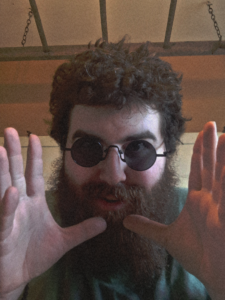 Hello, I’m Owen “Solar” Henry. I’ve been conlanging for 10 years, since the beginning of middle school, and as I’ve grown I’ve learned a lot and have been pushed into deeper knowledge by my peers and friends. I’ve worked on a language Kea for most of my time conlanging, and other small projects, but most notably I’ve been a part of Collin Gorrie’s historical linguistics challenge. Hello, I’m Owen “Solar” Henry. I’ve been conlanging for 10 years, since the beginning of middle school, and as I’ve grown I’ve learned a lot and have been pushed into deeper knowledge by my peers and friends. I’ve worked on a language Kea for most of my time conlanging, and other small projects, but most notably I’ve been a part of Collin Gorrie’s historical linguistics challenge.YouTube: @deepsolar169 Discord: @deep.solar |
|
| Sat 08:40 S I Sat 16:15 GP I |
Sidney Welsh | Best Practices for Conlanging with Fluency | It’s hard to create naturalistic conlangs. We make them with elegant theoretical backbones, but this isn’t how real languages work. Basques don’t care that their language is Ergative, but it works perfectly, because it’s intuitive for them.
In this presentation, I share some of my learnings and conclusions on conlang development, specifically focusing on this sense of intuition or fluency. I tell the story of how, by using my language Khơlīvh Ɯr extensively, without thinking about its grammar, I made the language far better, nearing a state of conlang nirvana. For example, by creating a huge map of the Khơlīvh Empire with hundreds of tiny inscriptions, I became fluent both in speaking and writing. Khơlīvh uses a logography even larger than that of Chinese, so I thought it would be daunting to learn to write, but I did so accidentally. As a result, the language itself gained a unique flavor, one which is difficult to describe, and impossible to create intentionally. |
Sidney Welsh (he/they) is a musician, linguist, conlanger, and general art person from Seattle, working to revitalize the native dxʷləšucid language, to make complex conlangs, and even more complex metal.
Discord: @arbitervonwien |
|
| Sun 11:15 S I | Jessica Heady | Challenging Linguistic Assumptions Regarding Sign Languages: A Conlang Thought Experiment | Due in part to the youth of signed languages relative to spoken languages, there is still a widely held belief that signed languages are not independent languages but signed representations of spoken languages. This controversial belief held among some laymen and academics alike inspired me to create a thought experiment challenging such ideas. This then led to two conlangs (1 signed and 1 spoken) that provide considerable insight into language evolution and how sign languages- if given the time to naturally grow and evolve as a language used as a dominant medium of communication- could potentially be structured.
The following is a thought experiment designed to challenge the belief among academics and non-academics alike that sign languages are not independent from spoken language. Here, I will posit a hypothetical world in which sign languages are the dominant form of communication over spoken language. I will create an a priori sign language that is entirely independent from existing signed or spoken language. The result is a hypothetical world reshaped in ways that provide useful insight into the linguistic similarities and differences between signed and spoken Language. Due to my limited timeline, I have only developed 1 sign language and propose how hearing people might create a spoken language. This could, however, be expanded upon to examine how cultural differences might affect the culture surrounding this language and how dialects may form from these languages. |
I am a first-year PhD student at the University of Florida studying linguistics. My academic interests are in Computational Linguistics, Syntax, and Sign Languages. I work on the Reanimating African American Histories of the Gulf South Project as Project Coordinator. There, we study the morphosyntactic features of AAL in the Gulf South. In the future, I would like to create a similar collection of ASL oral histories for linguistic research. | |
| Sun 14:20 G IR | Joey Windsor Daniel Swanson Alex Fink Sai |
Conlang Relay Presentation (Three Rings) | See relay page for details. | 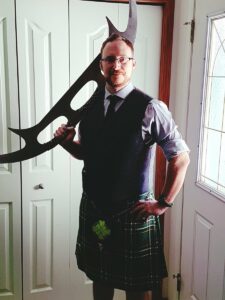 Joey is the relay master and poetry ring master. Joey is the relay master and poetry ring master.
|
|
| Sun 10:20 G I | Gabriel Swai | Conlanging Through an Autosegmental Lens | First proposed in John A. Goldsmith’s (1976) PhD dissertation at the Massachusetts Institute of Technology, autosegmental phonology is a generative framework that continues to hold relevance in modern phonology. In contrast to traditional linear models, autosegmental analysis separates segments into distinct tiers (Goldsmith, 1990). These autosegments are able to act autonomously from those on other tiers—hence the prefix “auto-”. The independence of these segments allows for a better representation of many processes in natural languages across the world, such as tone, nonconcatenative morphology, vowel harmony, etc. Because of this, an understanding of autosegmental phonology allows a conlanger to add creative yet naturalistic features to their languages that may appear counterintuitive or be difficult to conceive of through a traditional phonological lens.
The transfixation present in many Semitic languages is an effective example of the advantages of the autosegmental model (Goldsmith, 1990). Roots in Arabic, for instance, are typically a series of three consonants that are derived or inflected by a pattern of vowels inserted into that root. As an example, the root k–t–b is used in words related to writing: kataba كتب “he wrote”, yaktubu يكتب “he is writing”, katb كتب “writing (n.)”, etc. (Wehr & J. Milton Cowan, 1979). Placing the consonants onto a separate tier from the vowels allows for the vocalic transfixes to be swapped autonomously from the consonantal root. Understanding the autosegmental analysis of this particular natural phenomenon can help a conlanger more easily devise other imaginative nonconcatenative morphological features that are best explained with a model that utilizes different tiers. For example, one could be inspired to create a system of derivation with consonantal and vocalic roots and tonal transfixes on a separate tier, meaning the tonal pattern of a word would change its meaning. This is just one of the many ways that a knowledge of autosegmental phonology can help conlangers add inventive features to their languages; it’s been quite a useful tool for me personally in my own language creation. Using Goldsmith’s (1990) book Autosegmental and Metrical Phonology as a guide, I begin the presentation by introducing autosegmental phonology as a concept. Then, with this basic understanding, I give examples of how the framework describes certain linguistic processes, including (but not limited to) tone, floating segments, nonconcatenative morphology, and compensatory lengthening. Finally, I give examples of how autosegmental analysis of these phenomena can be used to design creative features in a naturalistic conlang. References
|
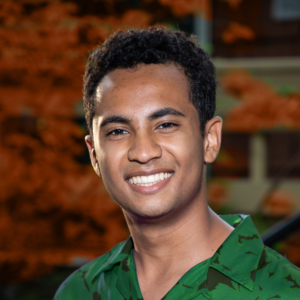 Gabriel Swai is a current high school senior from Cleveland, Ohio, matriculating to Dartmouth College for linguistics this fall. Living the first few years of his life within view of Mount Kilimanjaro in Tanzania—one of the world’s most linguistically diverse countries—he was surrounded by a diverse range of languages from Maasai to Kimachame (his clan’s mother tongue), which sparked his initial passion for language. He is a conlanger, amateur linguist, and language learner with a particular interest in phonology, tone, historical linguistics, typology, African languages, Indigenous American languages, and language documentation. Outside of language, he enjoys backpacking, coding, and trying new flavors at his local ice cream shop. Gabriel Swai is a current high school senior from Cleveland, Ohio, matriculating to Dartmouth College for linguistics this fall. Living the first few years of his life within view of Mount Kilimanjaro in Tanzania—one of the world’s most linguistically diverse countries—he was surrounded by a diverse range of languages from Maasai to Kimachame (his clan’s mother tongue), which sparked his initial passion for language. He is a conlanger, amateur linguist, and language learner with a particular interest in phonology, tone, historical linguistics, typology, African languages, Indigenous American languages, and language documentation. Outside of language, he enjoys backpacking, coding, and trying new flavors at his local ice cream shop.
Email: gabriel.swai@nullconlang.org |
|
| Sat 16:15 GP I | Julia Papke Micha Elsner |
Conlangs at Ohio State | We’re presenting on the Ohio State University’s LING 3502 “The Linguistics of Constructed Languages”, a conlang construction course which is now nearly 10 years old. Ohio State’s constructed language course emphasizes both the art and the science of language creation, by asking students to complete a semester-long project in which they build a language from start to finish. It provides a foundation in linguistics, emphasizing skills from documentation (Leipzig glossing) and typology, so that students can give useful feedback on each others’ work. It also presents influential conlangs and conlanging culture, concluding the class with a short relay. Our experience with the class points out the potential of language construction to reach people from both inside and outside the linguistics major, and the ways in which providing structure, a community, and an audience can help hobbyist conlangers to take the next step towards more sophisticated creations. | 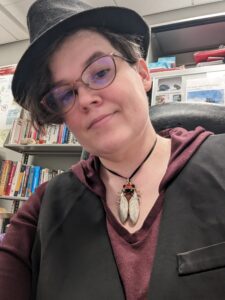 Julia Papke (he/she/they) works at the Ohio State University, where they designed Linguistics 3502, “The Linguistics of Constructed Languages”, in 2017. As an instructor for the class, Julia designed Caeb-Human Interlanguage, a signed conlang; and is currently working on an amphibious language tentatively titled “Memish”. They co-created ‘Intlis, a Klingon-English creole, with Micha Elsner. Julia has a Ph.D. in Linguistics from Ohio State, and their background is in historical linguistics, Indo-European, and contact linguistics. Discord @kalirush. Julia Papke (he/she/they) works at the Ohio State University, where they designed Linguistics 3502, “The Linguistics of Constructed Languages”, in 2017. As an instructor for the class, Julia designed Caeb-Human Interlanguage, a signed conlang; and is currently working on an amphibious language tentatively titled “Memish”. They co-created ‘Intlis, a Klingon-English creole, with Micha Elsner. Julia has a Ph.D. in Linguistics from Ohio State, and their background is in historical linguistics, Indo-European, and contact linguistics. Discord @kalirush.
|
|
| Sat 09:00 T I Sun 11:00 T I |
Sheldon Cooper | Conpidgin Formation Workshop | In this workshop, we build a conpidgin in person using props, drawing, gestures, and non-english languages with the same starting rules as for Viossa—’no translation’; and ‘if you can understand, they’re speaking the conpidgin’. We begin with a brief explanation of the rules and guidelines for the next period of time. Then, we move to construction and attempting to communicate with the conpidgin. Though we do not end the session with a fully functional language, the goal is to play the game of pidgin formation and to see on a micro-scale how a conpidgin can form and evolve organically. We also demonstrate how the process of making a conpidgin is fundamentally different from even other collaborative conlangs. | 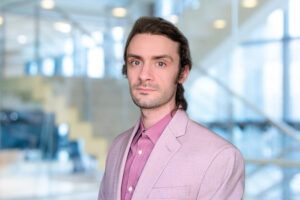 I am Sheldon (Nikomiko), one of the longest speakers of viossa (over 10 years). I was there shortly after it was created in 2014. I am 28 and live in Bethlehem. I graduated from USF with BA World Languages and Cultures: Applied Linguistics and Russian Language. I am Sheldon (Nikomiko), one of the longest speakers of viossa (over 10 years). I was there shortly after it was created in 2014. I am 28 and live in Bethlehem. I graduated from USF with BA World Languages and Cultures: Applied Linguistics and Russian Language. |
|
| Sat 15:15 G IR | Julia Papke John H. G. Scott Jonathan N. Washington Joseph W. Windsor |
Constructed Languages in the Academy: Experiences, Challenges, and Potential | Conlangs have centuries of history among intellectuals and creatives, yet have faced a variety of attitudes for and against their legitimacy in modern higher education contexts (i.e., college, university). This panel aims (a) to share a variety of ways that conlangs have been fruitfully employed in pursuit of academic goals in higher education, (b) to explore the ever-changing landscape of challenges that conlangs must still overcome, and (c) ways that conlangs can help us overcome certain challenges in academic settings.
The panelists, all academic professionals who have used constructed languages in their teaching, research, or professional development work, briefly summarize their experiences with conlangs in academic settings. We describe conlang courses we have taught within and outside of linguistics programs, at large public and small private schools, and the variety of learning objectives and outcomes they have served for students. We discuss the use of conlangs (including sketchlangs) for the creation of problem sets in linguistics courses, and the ethical and intellectual pros and cons of this practice. An innovative use of a conlang for the purpose of professional training for new university-level foreign language teachers is also described in terms of its benefits for fostering teacher empathy for learners and teachers’ own metalinguistic analytical skills. Examples of conlangs used for academic scholarship, including research about conlangs, experimental linguistic research using conlangs, and pedagogical perspectives on the value of conlangs for teaching purposes are also discussed. After framing some of the challenges that conlangs face in academic settings and some of the challenges that conlangs can help academic professionals address, the panelists will invite an open Q&A and discussion with the audience. |
 Julia Papke has a PhD in Linguistics from the Ohio State University, with a background in historical linguistics, Indo-European, and contact linguistics. They have been teaching and doing course development in higher education since 2004, and for the last 15 years, they have worked full-time as an instructor and program coordinator at Ohio State. They designed Linguistics 3502 “The Linguistics of Constructed Languages” in 2017, and are currently teaching it for the 9th time. Julia Papke has a PhD in Linguistics from the Ohio State University, with a background in historical linguistics, Indo-European, and contact linguistics. They have been teaching and doing course development in higher education since 2004, and for the last 15 years, they have worked full-time as an instructor and program coordinator at Ohio State. They designed Linguistics 3502 “The Linguistics of Constructed Languages” in 2017, and are currently teaching it for the 9th time.
They have created or co-created several conlangs, including Caeb-Human Interlanguage, a signed language; and ‘Intlis, a creole-like contact language based on English and Klingon. Their current project is an amphibious language tentatively called Memish. Discord @kalirush.
Jonathan is an Associate Professor of Linguistics at Swarthmore College whose research interests include a range of questions in phonetics and phonology and close investigation of Turkic languages and their history. Jonathan also develops and promotes language technology for marginalised languages, emphasising approaches that prioritise community needs, such as decolonising practices and free/open-source licenses and standards. Jonathan’s Ph.D. from Indiana University is in Linguistics and Central Eurasian Studies, and at Swarthmore they’ve had the privilege of leading a course entitled Linguistic Typology and Constructed Languages. Jonathan entered linguistics in part through conlanging and the online conlanging community (their first linguistics teachers) beginning in the 9th grade. While generally too busy to conlang these days, Jonathan occasionally steals moments to ponder next moves on ɕoam.
As a conlanger, Joey was President of the LCS from 2018–2024, where one of his primary foci was increasing acceptance of conlangs in academic settings. His interests are in creating naturalistic languages for use in fantasy role-playing games, and he has created more than 20 languages to date, both for himself and for clients in a professional setting. He is also a Klingonist, and has published on the second language stress acquisition of Klingon in the Journal of the Canadian Linguistic Association. The language he is most frequently working on now is Dal’a, a language for a Dungeons & Dragons setting that features retroflex consonants, VSO order, post-positions, and a writing system based on Middle Egyptian hieroglyphics. |
|
| Sat 08:45 S I Sat 16:15 GP I |
Bruce Arthur | Cuneiform for Conlanging | This presentation will provide tips and tricks on using the writing system of Gilgamesh, Hammurabi, and Ea-Nasir for your next conlanging project. We’ll cover how natural languages used cuneiform, how ancient scribes wrote it, the fun and useful features of cuneiform, and the potential shortcomings of cuneiform as a writing system for your conlang. The presenter will use his own experience creating a conlang written in cuneiform to provide advice while also identifying fun challenges for you to solve in your next cuneiform conlang. | 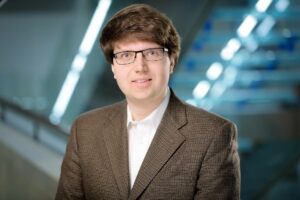 I create naturalistic conlangs rooted in specific real-world times and places. My conlangs display the areal features of the places they are from and typically have significant influence (including borrowings) from the natural languages nearby. Grammars of some of my conlangs are available on Amazon. I create naturalistic conlangs rooted in specific real-world times and places. My conlangs display the areal features of the places they are from and typically have significant influence (including borrowings) from the natural languages nearby. Grammars of some of my conlangs are available on Amazon. |
|
| Sun 14:00 S R | John A. Prado | Decolonizing Artistic Language Construction | Recent discourse in “pop linguistics” (cf. Hieber 2024) reveals unfortunate impressions (virtual) language construction communities leave, in an anecdotal way, on linguists—in particular, some working in revitalization. A criticism levied against language creators has been that artistic constructed languages are eurocentrist (Bernfeld 2024; Hieber 2024), and insofar as most language construction communities are virtual and most language creators create with digital media, this paper responds to this critical discourse and attempts to guard against the notion that “the internet […] entail[s] colonial appropriation” with an early pass at a decolonizing methodology for the language creator (Iliadis et al. 2023). On this approach, the language creator may work toward detaching one’s practice from eurocentrist (or anglocentrist; cf. Phillipson 1992) knowledges in order for one’s products to better stand up to the (often violent) forces of linguistic imperialism.
Dispensing with the rebuttal that language construction falls under the purview of the arts—not the social sciences—and that for this reason the criticism that artistic language construction is a waste of time and skill does not hold water, it is curious that a vast majority of language creators are from anglophone countries (Allen 2024a) and that these populations create the majority of constructed languages which are expressly artistic (Allen 2024b). There is no real conspiracy here, granted, but to the extent that the arts make an excellent medium for a decolonial program (cf. Gamedze 2015), the language creator ought, as this paper contends, to interrogates all one’s concepts in relation to all the artistic—academic networks one might inhabit. As meant here, decolonization obtains in the relation between the language creator and two general domains: individual practice—i.e., integration of decolonial learning (cf. Thambinatham & Kinsella 2021) with language construction methodologies—; and community product—i.e., artifactualization of the constructed language as a collaborative decolonial activity. In practice, we ought to declare why we are constructing a language, examine what knowledges (or knowledge systems) the language represents and how, and ask who constitutes the language. The task is to interrogate the following: the artistic intention, methodology, and goal of the artifact; the manner in which its imagined speakers’ knowledges are represented in (or by or with) the constructed language; the “metarepresentation” (i.e., the fictional geopolitics of the speakers) of the constructed language. In product: we ask ourselves what we are producing, where and how the artifacts are accessed (and in what natural language any “metadata” are written), and, most importantly, what the artistic constructed language does for or says about linguistic decolonization. Items in this set include the communicative content and medium of the artifact and the language creator’s relationship to and engagement in the (virtual) language construction community in which artifacts are shared and documentations published. These are necessarily non-exhaustive lists, open to additions and revisions, and particularly welcome is input from Indigenous language creators (of which it appears there are very few). The objective is a language construction methodology whose products are (received by nonpractitioners as) tools for epistemic decolonization (cf. Kastrissos 2023). The constructed language is a work of art, so why not make it mean something good?
|
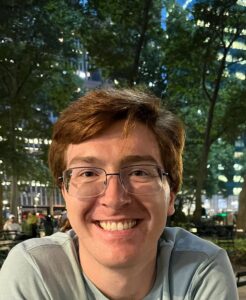 I am a linguist (B.A., University of Texas—Austin) and classical language educator (M.A., University of Texas—Austin). My background is in Latin philology and pedagogy, but I have also worked with Greek and Russian. I am a current postbaccalaureate linguistics student at Columbia University in preparation for doctoral study in linguistics. Though a longtime member of several virtual language construction communities, my foci today, in addition to culturally responsive pedagogy, are language documentation—revitalization and theoretical semantics—pragmatics. My Reddit handle is u/AndrewtheConlanger — I prefer my first name, John, now — and my Instagram handle is @atcatx. Please feel welcome to contact me on those platforms or via email. I am a linguist (B.A., University of Texas—Austin) and classical language educator (M.A., University of Texas—Austin). My background is in Latin philology and pedagogy, but I have also worked with Greek and Russian. I am a current postbaccalaureate linguistics student at Columbia University in preparation for doctoral study in linguistics. Though a longtime member of several virtual language construction communities, my foci today, in addition to culturally responsive pedagogy, are language documentation—revitalization and theoretical semantics—pragmatics. My Reddit handle is u/AndrewtheConlanger — I prefer my first name, John, now — and my Instagram handle is @atcatx. Please feel welcome to contact me on those platforms or via email. |
|
| Sun 10:50 S R | Red The Wizard | Dragon Language in L.R. Lam’s Dragon Scales series | This is a short introduction to the language I created for L. R. Lam’s fantasy novels Dragonfall and Emberclaw, and a look into the process of creating a conlang for commission. | 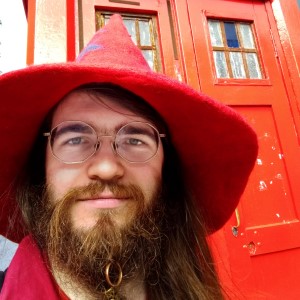 Red The Wizard (also known as Seumas) is a superintelligent shade of the colour red, in the shape of a wizard. Aside from conlanging, their linguistic interests are language change and supporting Scottish Gaelic. Usually found in Scotland, sometimes elsewhere in Europe. Red The Wizard (also known as Seumas) is a superintelligent shade of the colour red, in the shape of a wizard. Aside from conlanging, their linguistic interests are language change and supporting Scottish Gaelic. Usually found in Scotland, sometimes elsewhere in Europe. |
|
| Sat 11:35 S R | Amala | Dzadzan Adjectival Words | This focuses on a single feature of Dzadza, the system of using words adjectivally. Dzadza was created to have as simple a grammar as possible, almost like my creole project where grammar was supposed to emerge from using it. So it was seeded with very few official forms, though it has picked up some over the years. It also has lax assignment of words to specific parts of speech.
As it happens, I ended up nonetheless with three different ways to use a word adjectivally: as a copula complement, as a verb, and as an adjective which declines to agree with the noun. When used adjectivally, declining, it singles out the noun, and the implication is the noun is unique in some way in having the trait, is the only one with the trait. When used with a copula it implies the trait is inherent, is stable, requires no upkeep, perhaps could not be changed. When used verbally, it implies the trait is upkept as a matter of effort, that the subject actively maintains the trait, willingly participates in having it, creates it out of nothing. The presentation will (hopefully) be made in Dzadza, as a very short talk, and pre-recorded. The voice in Dzadza, captions (supplied by me) in English, presented over slides, is my plan. |
I conlang for fun and profit.
I love to put together languages, and to take them apart. I dissect reference grammars and use their parts to create new languages. I translate to pay homage to the things I love. Website: sites.google.com/view/amalaconlang |
|
| Sat 10:20 G R | Toona | Elná: The Language of the Mountains and the Plains | Elná is a language I have been working on for a year now. It is the final work of art, a combination, a mish-and-mash of my previous failed conlangs. I combined aspects of all, with some cool stuff that I was glad to add, and here is Elná.
The Elná language is spoken by the Éskerin people in the country of Ésker, all in the fictional continent of Euna. The Éskerin have a great love for nature, water, the mountains, horse-riding and the stars. We can see this love in their language too, for example in Elná one says “I am looking into the stars” to explain the feeling of mesmerisation and amazement (iki nie léan); the Éskerin do not say that their fate has shown them the path, they say that the nature has given it to them (te Hoa íma). The language is fascinating as it is too, featuring ergativity, obbiative-proximative distinction, VSO word order and my favourite part: affixes that present great complexity and beauty to the language, for instance the verbal infix “-na-” (that developed from an exclamation featuring the topic marker “nai”) denotes that the action was committed in an skilled manner, with the intention of art; the verb “luasi” means to say, and “luanasi” means to say in an artful way, to recite. |
I am from Turkey, but I am from an ethnic minority, the Kurds. This didn’t really affect my conlanging journey, but also knowing the Kurdish language it inspired me to add various features of Kurdish to my conlangs (especially Elná). You can see that the Éskerin people also mimicks the Kurds’ life style, among other peoples. I am really really young for a conlanger, I am 15, I go to a high school in the Turkish city Kocaeli which is a neighbour of Istanbul. I speak 5 languages fluently (Turkish, Kurdish, English, German, Spanish) and I don’t know how many semi-fluently or less fluently. I am a huge language nerd, not just language but I am a fan of all of the scientific field. I regularly post on my X account @Toona_TR. | |
| Sun 11:30 S R | Brian Bourque | How Conlanging and Post Traumatic Stress can be Mutually Beneficial | It has been long understood that art can help people express thoughts and feelings and cope with loss and/or pain. Just as art can have an affect on a person’s emotional state and vice versa, the same can be true for conlanging—if not more directly. Some conlangers created a way to express themselves without fear of judgment or reprisal with a personal language. This presentation will focus on how trauma response can influence world-building and, conversely, how conlanging can positively affect post traumatic stress. | My name is Brian Bourque. I was born and raised in southern New Hampshire (near Boston). I am a 20-year, active duty military retired veteran and I was a translator. English is my mother tongue and I can speak well in Korean, Persian, and French, and beginner level in German. I have lived in Germany, Belgium (French-speaking part) and South Korea. I am the creator of Lortho and Dhakhsh. You can find me on Mastodon (@bbbourq@nulllingo.lol), Discord (@bbbourq), and Reddit (u/bbbourq). he/him/his | |
| Sat 14:40 G R | Dillon Hartwig | Hurdles when making your first signed conlang, and what they can teach you | When I started on my first signed conlang Frangian Sign (named after Frangia, a continent on the conworld of the collaborative Pollasena project), I’d already been conlanging for a while, and because of that there were parts of my usual conlanging process I took for granted as easy but were far from it. The main hurdles were differences from my spoken conlangs in documentation, notation, and setting-external translation/interpreting.
Those hurdles were good learning opportunities though, and getting past them has made not just my signed conlanging but also my non-signed conlanging better. In this talk I go over what I learned to save future sign-conlangers some time and frustration, and to give conlangers in general a chance to think about what parts of conlanging they take for granted.
|
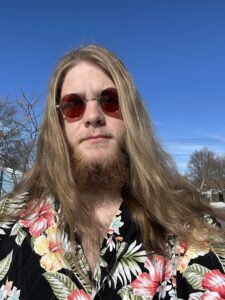 Howdy, I’m Dillon, a conlanger since 2009, language tutor since 2020, and parent since early 2024 of what’ll hopefully be another conlanger some day.BlueSky: @biskyriznu.bsky.social Discord: @engt Reddit: u/Dillon_Hartwig Linguifex: User:Dillon |
|
| Fri 16:15 J+ I | Rylan Wetsell | I Search for My Soul: A Poem in Soma | A reading of a short poem in the conlang Soma, preceded by a short explanation of its structure and concultural significance. | Rylan Wetsell is a 15-year-old conlanger and conworlder from Nashville, Tennessee. He has been conlanging for over 2 years. He is known as HolyHandGrenade! on the CBB, Discord @holy.hand.grenade. | |
| Sat 14:40 S I Sat 16:15 GP I |
Alex Howe | Interstellar Common: An Alien Auxlang | I present my in-progress conlang and conscript, Interstellar Common. Interstellar Common is an auxlang used by aliens across the galaxy in a planned space opera story. The concept behind it is that the language grew organically out of first contact packages sent to young civilizations as each new planet joined the galactic community, developing their own translation protocols in the process. The result is a sprawling dialect continuum that nonetheless shares some key common features, and a purely logographic language, meant to be read in each speaker’s native tongue, so that it can be used as a lingua franca by species with very different biologies and psychologies. I outline the process of how I extrapolated from a symbolic representation of basic mathematics and physics to a fully fleshed-out grammar, and my attempts to create a writing system that is fully indexable despite being logographic and containing no phonemic content. | 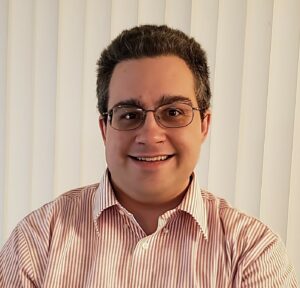 I am an astrophysicist by trade, and I have long dabbled in science fiction writing and worldbuilding. I’ve done some conlanging in the background throughout this process, but I became more active after 2020 when I was drawn into the science and math YouTube community, and subsequently the worldbuilding and conlanging community. Today, I continue to make videos about all of these subjects as well as my other social media presence, including a semi-regular podcast about the history of science fiction. I am an astrophysicist by trade, and I have long dabbled in science fiction writing and worldbuilding. I’ve done some conlanging in the background throughout this process, but I became more active after 2020 when I was drawn into the science and math YouTube community, and subsequently the worldbuilding and conlanging community. Today, I continue to make videos about all of these subjects as well as my other social media presence, including a semi-regular podcast about the history of science fiction.
YouTube: @ScienceMeetsFiction |
|
| Sun 08:15 G I | Zie Weaver | Introduction to Loglanging | At present, loglanging is an arcane art passed primarily via oral tradition with few online resources. Therefore, we present a first lesson in loglanging: Building on the attendees’ existing conlanging knowledge, we will build minimum viable loglang analyzing the rudiments of the design space. This talk is designed for conlangers that are interested in creating a loglang, but feel intimidated and do not know where to start.
Beginning discussing the various known self-segrementing morphology (SSM) techniques, including both prosodic and morphologic approaches, we will build a small tokenizer including a quick excursion into which parsing techniques are available and favored by today’s loglangers. Next, we will discuss the merits of morphological word classes as context for discussing building a lexicon. However, before adding words to our language, we digress to a quick review of first order predicate logic and lambda calculus and their influence on loglang design. With these mathematical systems in the back of our mind, we examine some of the syntactic choices available to loglangers and how simple choices for other conlangs, e.g. word order, have profound impact on a loglang. Once we have made some simple syntactic choices, we turn our attention to building a simple parser for the loglang, which will take a majority of our time along with interjections into how to think about a language from a precise syntactic perspective. We can conclude the design by discussing basic semantic choices a conlang will face such as plural logic, tense systems, the “shape” of a word’s arguments, and context management. Finally, we will diagram a few simple example sentences. Pre-requisites:
|
 Zie Weaver is a professional software engineer specializing in large scale refactoring by day and a loglang enthusiast by night. She has studied Lojban for almost two decades and is one of the few conversational speakers. Her interests have blossomed far beyond this language alone, and has studied loglangs generally for five years (and is developing a few of her own). Zie Weaver is a professional software engineer specializing in large scale refactoring by day and a loglang enthusiast by night. She has studied Lojban for almost two decades and is one of the few conversational speakers. Her interests have blossomed far beyond this language alone, and has studied loglangs generally for five years (and is developing a few of her own).
Discord: @zearen |
|
| Sat 09:45 S R | Ben Norton | Introduction to the Omati Language | This talk introduces my constructed language, Omati. After providing a brief overview of the Omati alphabet and orthography, I will proceed to delineate how this constructed script has evolved, from me initially creating it as a decorative script for the Omaha language (a natural language spoken in the Midwest region of the United States) to me repurposing the script for my own constructed language. I will conclude with sharing how Omati is used in conjunction with my other constructed language, Nuráma, which are both languages used in my constructed world. | 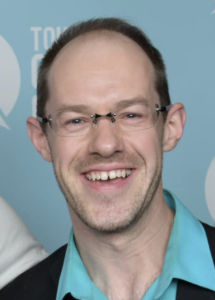 Ben Norton is a language enthusiast living in Tokyo, Japan. He was born and raised in Lincoln, Nebraska (USA) and has created various conscripts such as Nortish (for English), Pī‘āpā Hou (for Hawaiian), and Wébaxu Ní (for Omaha). He has also developed conlangs based on these conscripts such as Nuráma and Omati. The aforementioned conlangs are part of a graphic novel currently in development. Ben Norton is a language enthusiast living in Tokyo, Japan. He was born and raised in Lincoln, Nebraska (USA) and has created various conscripts such as Nortish (for English), Pī‘āpā Hou (for Hawaiian), and Wébaxu Ní (for Omaha). He has also developed conlangs based on these conscripts such as Nuráma and Omati. The aforementioned conlangs are part of a graphic novel currently in development.
YouTube @brushesbladesconlang |
|
| Sat 08:45 G I | Tony Harris | Kie trovi Esperantujon? (Where to find Esperantoland?) | Esperanto may not have achieved its initial aim of becoming the second language for everyone, but it has developed an active and vibrant culture of Esperantists, both at in person events and online, and a rich literature. This talk presents a quick overview of that culture, where to find Esperantists and Esperanto resources. | 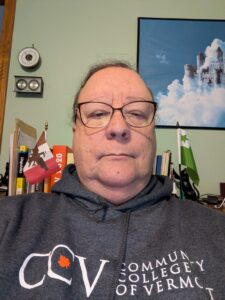 Tony is the creator of the Alurhsa, Tariatta, Qalonse, and Ku Tal languages as well as a long time Esperantist, and fairly conversational in French, Spanish, and Intelingua, with varying levels of knowledge of several other languages. He is also the lending librarian and one of the web tech support staff for the LCS, and the host of the weekly Conlanger Chats on Zoom. He recently retired after 42 years in IT, and lives in Central Vermont with his wife and 3 cats. Tony is the creator of the Alurhsa, Tariatta, Qalonse, and Ku Tal languages as well as a long time Esperantist, and fairly conversational in French, Spanish, and Intelingua, with varying levels of knowledge of several other languages. He is also the lending librarian and one of the web tech support staff for the LCS, and the host of the weekly Conlanger Chats on Zoom. He recently retired after 42 years in IT, and lives in Central Vermont with his wife and 3 cats. |
|
| Sun 13:05 G R | Matt Jarman | Learn and Spread Spoken Languages More Easily Using Iconic & Translucent Manual Signs | We want people to remember and use constructed languages. In this presentation, I explain the ways in which iconic and translucent manual/hand signs make it easier to learn and spread languages. Iconic signs are hand signs whose meaning is relatively intuitive (i.e., you can guess what the sign means), though this may vary across cultures. Translucent signs are not immediately recognizable but make sense once explained (Klima & Bellugi, 1979), again, with some variability across cultures. In this presentation, I explain how John Bonvillian et al.’s Simplified Sign System – a collection of iconic and translucent signs (not a sign language) – can be integrated into language learning and teaching.
Using Toki Pona as an example, I share my “Toki Pona luka pi kama sona” (Toki Pona hand signs of learning), where I paired Toki Pona words with iconic and translucent hand signs. I explain how this use of signs makes it easier to learn/remember language vocabulary, learn through language immersion, learn multiple languages, and minimize resorting to your first language when you’ve forgotten a word. I also talk about how such signs can be a bridge to enable interaction between people speaking different (constructed) languages. Imagine being able to speak/practice your constructed language with your friend who doesn’t speak it, but they can still follow what you’re saying! An overarching theme of the presentation is how iconic and translucent signs make it easier for people to actually speak/practice a language. References
|
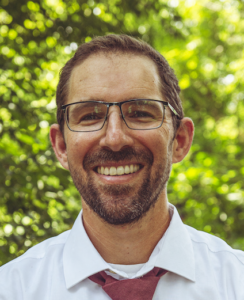 Matt’s (he/him) greatest passion is speaking different languages – he speaks Spanish, French, and Toki Pona. Though relatively new to Toki Pona, he teaches the language in a class for homeschoolers using an iconic sign language approach. Matt is a productivity psychologist, former psychology professor, and now an ADHD coach for undergrad students, grad students, and working professionals (productiveforgood.org). Matt lives in Ithaca, New York. Matt’s (he/him) greatest passion is speaking different languages – he speaks Spanish, French, and Toki Pona. Though relatively new to Toki Pona, he teaches the language in a class for homeschoolers using an iconic sign language approach. Matt is a productivity psychologist, former psychology professor, and now an ADHD coach for undergrad students, grad students, and working professionals (productiveforgood.org). Matt lives in Ithaca, New York. |
|
| Sat 17:30 S I | Carter (kartero) Williams | Lessons To Learn From Esperanto: An Interactive Retrospective | While it never became the universal second language its creator envisioned, Esperanto continues to enjoy productive use in global congresses, online communities, and even within households. Despite being rejected as an official language of the UN, you can read the UNESCO Courier and take a CEFR exam in Esperanto. This is a level of success that its early contemporaries never achieved. Is this a product of chance, or is there something we can learn from history? Was the failure of the “fina venko” inevitable, or can we point out misguided decisions that were responsible the Esperanto’s lack of adoption?
This talk explores the factors contributing to the language’s successes and shortcomings, offering insights into the process of cultivating an International Auxiliary Language (IAL). Together we try to come to a consensus on the impact of various historical and linguistic considerations. Did Esperanto’s hard to print diacritics limit its spread via the press? Was Zamenhof’s humility a crucial factor in winning over Volapük enthusiasts? Did infighting among leftist factions prevent the movement from reaching critical mass? Was collaboration with those like-minded groups essential to its lasting presence? Is the word “scii” just too darn difficult to pronounce? Join me as we examine these questions and more. If all goes as planned, we’ll all walk away with practical insight into the craft of creating and fostering an IAL project. |
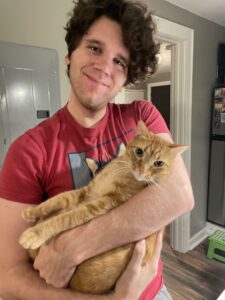 Carter (kartero) Williams (He/Him) is an esperantist with a general interest linguistics and auxiliary languages. He enjoys contributing crosswords to the Usona Esperantisto, reading in the language broadly and avidly, as well as regularly attending national and international congresses. He’s also happy to have contributed images of his brain to the MIT Brains on Conlangs study. Discord @gantar. Carter (kartero) Williams (He/Him) is an esperantist with a general interest linguistics and auxiliary languages. He enjoys contributing crosswords to the Usona Esperantisto, reading in the language broadly and avidly, as well as regularly attending national and international congresses. He’s also happy to have contributed images of his brain to the MIT Brains on Conlangs study. Discord @gantar. |
|
| Sun 13:35 S R | Fred Bayer | Lexicon Management: FieldWorks for Conlangers | SIL FieldWorks Language Explorer, also known as FLEx, is a free and open source software intended for use by field linguists to document natural languages. However, its unparalleled lexical documentation features also lend themselves to managing a conlang lexicon, and its relational database structure makes common tasks much easier to perform in bulk than other digital methods commonly used for this purpose, such as spreadsheets or even Lexique Pro. The programme has a steep learning curve and many find it daunting to get to grips with, particularly when the available documentation is not geared towards the conlanger’s use-case. This presentation offers an introduction to FieldWorks from a conlanger’s perspective, focussing primarily on the dictionary aspect of the software, but also providing a whistlestop tour of some other features such as grammar and import/export. | 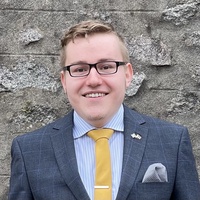 Fred Bayer was born in Cologne, Germany but has lived in Aberdeen, Scotland for over a decade. Raised in a polyglot environment, Fred first dabbled in conlanging as a teenager and has been actively engaged in online conlanging communities (primarily on Facebook) ever since. He is currently working on a new proto-language, Mundan, to eventually derive a family from. Fred Bayer was born in Cologne, Germany but has lived in Aberdeen, Scotland for over a decade. Raised in a polyglot environment, Fred first dabbled in conlanging as a teenager and has been actively engaged in online conlanging communities (primarily on Facebook) ever since. He is currently working on a new proto-language, Mundan, to eventually derive a family from. |
|
| Sat 13:20 S R | Alexey Kostyuhin (Костюхин Алексей) | Methods of creating “naturalness” and “alienness” of constructed languages (by the material of the Klingon and Na’vi languages) | The presentation is devoted to the methods of constructing artlangs as alien languages that are at the same time close to natural languages as exemplified by the material of the Na’vi language. The author shows that the structure of an artlang is determined by its main function within a work of art, i.e. aesthetic function. The construction of an artlang is pragmatically determined, on the one hand, by the necessity to demonstrate its essential difference from natural languages, on the other hand, to create a real means of communication that is reproduced by people and possesses all the features of a natural language. As the task of creating an alien language that will become an organic part of a fiction film is realized, the problem of keeping a balance between the “alienness” of an artlang and its plausibility arises. The latter can only be achieved by bringing its structure closer to natural languages. Such techniques that increase the proximity of an artlang to natural languages include invention of linguistic variation at all levels of the constructed system, creation of territorial dialects as forms of existence of the standard language, specific prosody as well as use of natural language sounds in order to create a credible phonological system.
References
|
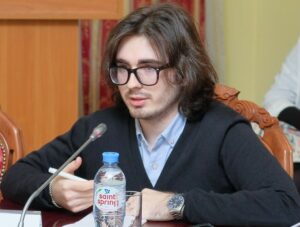 Linguist and Interpreter, Lecturer at the Department of German Language and Translation and Interpreting at Moscow State Linguistic University Linguist and Interpreter, Lecturer at the Department of German Language and Translation and Interpreting at Moscow State Linguistic University |
|
| Fri 16:20 J+ I Sat 13:15 G+ I Sat 17:25 G+ I Sun 08:00 G+ I Sun 10:15 G+ I Sun 15:20 G+ I |
Isabel Gardener | Noise and Bells | My name is Isabel Gardener, and I run a music and conlanging channel on YouTube called “Noise and Bells”, which is also the name of my independent music project. I intend to perform a set including 4-6 fully original songs with lyrics written in various constructed languages including Esperanto, Lojban, Loglan, Toki Pona, and potentially others. If I can bring my baritone ukulele, I will perform with it. Otherwise, I may need to locate a piano or keyboard of some sort. Examples of my songs can be found at my YouTube channel, @NoiseAndBells. | Isabel Gardener, known as “la janbe” to the Lojban community, is an American musician and civil rights attorney with a passion for conlanging. Whenever she’s not otherwise occupied fighting discrimination and mistreatment in Utah’s public school system, Isabel spends her time writing original songs about religion and social issues with lyrics in various conlangs, as part of an independent music project, “Noise and Bells”. In 2022, she began developing Xextan, a “compact logical language” inspired by Lojban and Toki Pona. She plays the piano, ukulele, harmonica, mallet percussion, and timpani — not to mention bells, of course! | |
| Sat 13:35 G I Sat 16:15 GP I |
Sai Alex Fink |
Non-linear art-poetry in UNLWS, Ouwi, & Rāvòz | In this talk and poster, Sai and Alex show off and explain a selection of art-poetry in their non-linear, fully two-dimensional, written language (NLF2DWS) UNLWS, the independent NLF2DWS Ouwi by Schuyler Duveen, and the UNLWS+Ouwi daughter NLF2DWS Rāvòz by Cypherous Skies — with contributions by themselves, Sky, Cyph, Jonathan Kane, Yamiko Hikari, and jan Talisoso.
They discuss how story-telling and poetry work without a fixed reading order; artistic/poetic devices invented by UNLWS community members; and some unique expressive features of non-linear poetry by Sky, Cyph, Jonathan, Yami, and jan Talisoso. Spoiler warning: this discusses the meaning and interpretation of the examples featured in it. You may get more enjoyment from translating them for yourself first — to do so, look on the UNLWS Discord #in-unlws forum and Rāvòz Discord #gallery forum respectively, where all translations are behind spoiler tags, before watching this. |
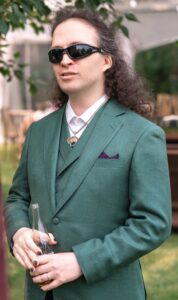 Sai (ASL: S-CAT) founded the Language Creation Society, authored the essays On the Design of an Ideal Language and NLF2DWS Design, met their now-husband Alex Fink due to LCC2, and co-created UNLWS and Gripping with him. They are a pure engelanger, interested in how to push the boundaries of language within what is natural to the medium even if unprecedented in the wild. Sai is light-blind and uses ASL to communicate when mute. Discord, Twitter, & YouTube @saizai, BlueSky @s.ai. Sai (ASL: S-CAT) founded the Language Creation Society, authored the essays On the Design of an Ideal Language and NLF2DWS Design, met their now-husband Alex Fink due to LCC2, and co-created UNLWS and Gripping with him. They are a pure engelanger, interested in how to push the boundaries of language within what is natural to the medium even if unprecedented in the wild. Sai is light-blind and uses ASL to communicate when mute. Discord, Twitter, & YouTube @saizai, BlueSky @s.ai.
|
|
| Sat 13:20 G I Sat 16:15 GP I |
Jackson Confer | Numozi Showcase | Numozi is an artlang evolved from Proto-Nomasic for TTRPG worldbuilding, designed with realism in mind. Numozi is the result of ~6000-8000 years of simulated evolution, and was heavily influenced by Basque, Turkish, Mycenean Greek, and Spanish. The Temple Numozi/Classical Nomasi variety was the administrative language of the Nomasi Empire, and remained a literary and liturgical language language well after the vernacular splintered into the daughter Numozic languages.
I purposefully made Numozi typologically unremarkable at the high level in order to give myself more leeway when using rare, unusual, or unattested phenomena elsewhere. Thus, Numozi has many very common properties, including SOV word order, CV syllables, a 5-place vowel system, and mostly agglutinative morphology. Its phonology has common allophonic processes, like voiced stop lenition, unstressed vowel reduction, and palatalization. Orthographic words correspond to prosodic words, and have a strict trochaic meter with a penultimate primary stress; prosodic words then correspond to clusters of heads within the syntax. The grammar, particularly the syntax, is informed by a flexible interpretation of bare-phrase-structure minimalism, with two major exceptions: (i) sidewards head movement and adjunction (for modeling agglutination), and (ii) inherent headedness, ignoring notions of antisymmetry or post-syntactic linearization. Some more interesting properties of Numozi include: split ergativity based on both polarity and reflexivity; rich inflection on both nominals and predicates; extra clusivity, including a special associative verb paradigm; and specific exceptions to headedness tendencies. Expanding on these: The default morphosyntactic alignment is Nom-Acc, and shifts to Erg-Abs in negated clauses, or when the arguments are reflexive; in case of both, it reverts back to Nom-Acc. Nominals vary between having the determiner as bound or unbounded morphology, and decline for 6 cases (Nom, Acc, Abs, Dat, Gen, Oblq). Noun classes have an animate/inanimate distinction, with another mixed-animacy category for ‘divine’ things. On verbs, aspect and phi-features surface as obligatory suffixes. Tense and polarity, marked by prefixes, can be omitted in the right discourse conditions. Since ergativity is tied to polarity, overt neg-marking on the verb can often be redundant, and tense marking is recoverable by context. There is a significant amount of allomorphy conditioned by how many other affixes are present. Verbs conjugate for clusivity, including associativity marking. Originally derived from the singular conjugations, there is special morphology used when talking as/to/about a single person on behalf of a group. For example, representatives from different groups parleying, speaking to each other as individuals but all understanding they speak on behalf of, to, and about plural groups. Most Numozi phrases are head-final, with the exception of: (i) coordinate structures (&-medial); (ii) complementizer phrases (always head-initial); and (iii) some adjuncts, namely adjectives and adverbs, follow the head in the underlying structure before movement. Since nominals agglutinate by head movement, nouns move across adjectives to adjoin with specific determiners. This leads to a distribution where adjectives surface before nouns in article/NEG constructions, with N having raised to D (‘the big dog’ ⇒ ‘big dog-the’/sua xause) and after nouns with all other determiners, such as demonstratives ( ‘this big dog’ ⇒ ‘dog big that’/xai sua zaxe). |
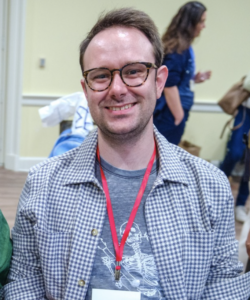 (he/him) I am a Baggett Fellow in the linguistics department at University of Maryland, College Park. I grew up in California, and I earned my B.A. in linguistics from University of California, Santa Cruz. I’m interested in a wide variety of syntactic and morphosyntactic phenomena, increasingly so in how they might interact with semantic or pragmatic considerations. My current research interests include ellipsis and coordinate structures in English, as well as exceptive constructions in Korean as part of Maria Polinsky and Eric Potsdam’s broader exceptives project. I’m interested in both formal and experimental approaches, believing that both can provide important insights into both the abstract structure and our own cognition of language. (he/him) I am a Baggett Fellow in the linguistics department at University of Maryland, College Park. I grew up in California, and I earned my B.A. in linguistics from University of California, Santa Cruz. I’m interested in a wide variety of syntactic and morphosyntactic phenomena, increasingly so in how they might interact with semantic or pragmatic considerations. My current research interests include ellipsis and coordinate structures in English, as well as exceptive constructions in Korean as part of Maria Polinsky and Eric Potsdam’s broader exceptives project. I’m interested in both formal and experimental approaches, believing that both can provide important insights into both the abstract structure and our own cognition of language.
I enjoy conlanging as an component of worldbuilding, where I prefer to make naturalistic artlang families through simulated evolution, contact, and death, with all of the peculiarities that come with those processes. I love being able to name locations, characters, institutions, and moments in history with actual names that mean actual things in-universe. I also find that simulating evolution and developing a grammar piecemeal helps me wrap my head around the patterns and phenomena I see in real-world languages. Outside of language-related things, I’m also a musician, pool player, TCG player, and enthusiastic home cook. |
|
| Sat 11:20 S I | Tony Harris | Overview of the Alurhsa Language | The Alurhsa language has been under development for over 48 years now, growing organically over that time, in use for journaling, note taking, spirituality, story telling, and more. At LCC5 Tony gave a talk on Living Your Language focusing on ways to grow, learn, and connect to your language, based on his many years with Alurhsa. This talk presents the history of that language growth along with a deeper dive into the Alurhsa language itself, how it sounds, how it works, and how it has evolved. See also LCC5, Living Your Language. |  Tony is the creator of the Alurhsa, Tariatta, Qalonse, and Ku Tal languages as well as a long time Esperantist, and fairly conversational in French, Spanish, and Intelingua, with varying levels of knowledge of several other languages. He is also the lending librarian and one of the web tech support staff for the LCS, and the host of the weekly Conlanger Chats on Zoom. He recently retired after 42 years in IT, and lives in Central Vermont with his wife and 3 cats. Tony is the creator of the Alurhsa, Tariatta, Qalonse, and Ku Tal languages as well as a long time Esperantist, and fairly conversational in French, Spanish, and Intelingua, with varying levels of knowledge of several other languages. He is also the lending librarian and one of the web tech support staff for the LCS, and the host of the weekly Conlanger Chats on Zoom. He recently retired after 42 years in IT, and lives in Central Vermont with his wife and 3 cats. |
|
| Sun 13:20 G IR | Sai Paul Frommer Jan van Steenbergen Britton Watkins Alex Fink |
Panel: Conlangers with lingvidos or conlang communities | The panellists have all created a conlang which has since developed a speaker community and/or lingvidos (daughter conlangs). They will open with an introduction about their conlang and experiences, and continue with a free-form discussion including moderator and audience prompts. |  Sai (ASL: S-CAT) founded the Language Creation Society, authored the essays On the Design of an Ideal Language and NLF2DWS Design, met their now-husband Alex Fink due to LCC2, and co-created UNLWS and Gripping with him. They are a pure engelanger, interested in how to push the boundaries of language within what is natural to the medium even if unprecedented in the wild. Sai is light-blind and uses ASL to communicate when mute. Discord, Twitter, & YouTube @saizai, BlueSky @s.ai. Sai (ASL: S-CAT) founded the Language Creation Society, authored the essays On the Design of an Ideal Language and NLF2DWS Design, met their now-husband Alex Fink due to LCC2, and co-created UNLWS and Gripping with him. They are a pure engelanger, interested in how to push the boundaries of language within what is natural to the medium even if unprecedented in the wild. Sai is light-blind and uses ASL to communicate when mute. Discord, Twitter, & YouTube @saizai, BlueSky @s.ai.
Paul Frommer, creator of the Na’vi language for James Cameron’s Avatar franchise, is Professor Emeritus of Clinical Business Communication and former Director of the Center for Management Communication at the Marshall School of Business of the University of Southern California. Prior to joining Marshall, he taught ESL and mathematics in Malaysia and ESL in Iran, and later earned a PhD in linguistics. His doctoral dissertation, “Post-verbal Phenomena in Colloquial Persian Syntax,” was completed under the direction of the noted linguistic typologist Bernard Comrie. Frommer is also the principal co-author of Looking at Languages, a workbook for elementary linguistics classes. His teaching at USC included courses in Advanced Writing for Business and Cross-Cultural Business Communication for Non-Native Speakers. Since the first Avatar film debuted, Frommer has worked on the Na’vi content of the sequels and also of the video game, Avatar: Frontiers of Pandora. Additionally, he continues to expand the language into a flexible medium of communication for an international community of Na’vi enthusiasts here on earth. He also developed Barsoomian, the Martian language for the Disney film John Carter.
|
|
| Sat 09:00 G I | John H. G. Scott Tony Harris James E. Hopkins |
Pelarkast: Three Makers of the Three-Maker Language | On March 17, 2024, the Pelarkast language was born at a table covered in the waste of delicious Thai food in a Maryland food court. With a rapidly developing cultural history, culinary variety, and metaphysically variable geography, Pelarkast is quickly maturing as a fruitful conlanging, conworlding, and conscripting collaboration, which gives rise to its own cultural context and idiomatic expressions, as well as insights into information density that often surprise its own creators.
The three founders of this conlang collaboration will discuss the project as an example of a successful conlang collaboration. We will start by describing our diverse approaches to conlanging practiced by each: bottom-up aesthetic discovery, iterative-contemplative “listening” to the language itself, and starting from structural constraints to observe how the resulting conlang’s patterns fall out. Next, we will share each creator’s contributions to Pelarkast–the ingredients of the secret sauce, as it were–ranging from phonotactic constraints and syntactic structures to cultural-semantic fields and Sapir-Whorfian verbal aspects. Finally, we will describe our perspectives on the project itself as an exercise in learning from each other and enjoying the experience of collaboration and compromise to see what the year-old Pelarkast language has to teach us as its creators. |
 John started conlanging as a teenager with Küyüki, a D&D naming language, which he expanded as he learned about linguistics for his BA. During graduate school, he led a team of volunteer creatives to produce the a posteriori Stygian conlang for a multinational LARP game called Space: The Infinite Edge, and he taught an undergraduate course on conlangs at Indiana University in 2015 and 2017. After earning his PhD in Second Language Studies in 2019, he was tapped by the Netflix Original show Archive 81 to create the Baldung language, an a posteriori artlang descendant of Old Saxon. He is currently working on five artlang projects, including documenting the Antichthonian, Nwâfzjùúl, and Paranthropic languages, co-creating the Pelarkast language, and using the Nejtiesie language as a training tool for the next generation of foreign language teachers. John started conlanging as a teenager with Küyüki, a D&D naming language, which he expanded as he learned about linguistics for his BA. During graduate school, he led a team of volunteer creatives to produce the a posteriori Stygian conlang for a multinational LARP game called Space: The Infinite Edge, and he taught an undergraduate course on conlangs at Indiana University in 2015 and 2017. After earning his PhD in Second Language Studies in 2019, he was tapped by the Netflix Original show Archive 81 to create the Baldung language, an a posteriori artlang descendant of Old Saxon. He is currently working on five artlang projects, including documenting the Antichthonian, Nwâfzjùúl, and Paranthropic languages, co-creating the Pelarkast language, and using the Nejtiesie language as a training tool for the next generation of foreign language teachers.
|
|
| Sun 13:05 S I | Margaret Ransdell-Green | Playing with Valency in Conlang Creation | In this presentation, I explore how conlangers can develop grammatical functions that manipulate verbal valency, either increasing or decreasing the number of arguments a verb requires. Valency refers to the number of core arguments a verb can take, and altering it through grammatical mechanisms can enhance the complexity and expressiveness of a conlang. We will examine a variety of strategies for manipulating valency, such as causativization, passivization, antipassivization, applicativization, and anticausativization, and show how these processes can be applied within different verbal alignment systems.
Drawing inspiration from natural languages, I discuss how certain constructions can be used to enhance the grammatical richness and expressive capability of a conlang. For example, causativization adds an argument (the causer), making a typically intransitive verb transitive, while applicativization introduces an additional argument to indicate the recipient or beneficiary of an action. We will also look at processes that decrease valency, such as anticausatives, which reduce a transitive verb to an intransitive form, and antipassives, which decrease valency and are particularly common in languages with ergative-absolutive verbal alignment. By combining these mechanisms with various verbal alignment systems, conlang creators can construct nuanced ways of expressing who is doing what to whom, enhancing both the diversity and functionality of their language. The presentation will provide examples from natural languages and conlangs, and suggest how these ideas can be integrated into a conlang’s structure, offering practical tools for constructing a sophisticated and flexible verbal system. References
|
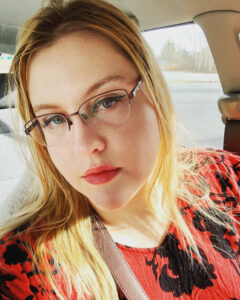 I (she/they) am a linguist and conlanger, focusing on phonology, historical linguistics, and language documentation. My doctorate is from the University of Hawai’i at Mānoa. I’m also a foreign language instructor at the University of Alaska Fairbanks, where I teach French. My interests in conlanging include morphosyntax, phonology, multi-modal languages, worldbuilding, professional conlanging, conlanging in music, and semantics. I have served on the Board of the LCS since 2021, first as Secretary and then as Vice President. I have served as its President since 2024. I (she/they) am a linguist and conlanger, focusing on phonology, historical linguistics, and language documentation. My doctorate is from the University of Hawai’i at Mānoa. I’m also a foreign language instructor at the University of Alaska Fairbanks, where I teach French. My interests in conlanging include morphosyntax, phonology, multi-modal languages, worldbuilding, professional conlanging, conlanging in music, and semantics. I have served on the Board of the LCS since 2021, first as Secretary and then as Vice President. I have served as its President since 2024.
Discord: mintaka55 Web: |
|
| Sun 10:50 G R | Corbin Simpson | Recognizing Logical Constructs in Conlangs | A short field guide to the most common logical constructs that we might encounter when studying constructed languages. | Corbin Simpson is a logician. Their past careers include jazz pianist, system administrator, and security consultant. Their hobbies include programming-language design, theory, and implementation. They currently advise small businesses and grow plants around Portland, Oregon. Their PeerTube is pastafriday.club. | |
| Sat 09:15 S R | George Corley | Rolling up a Language: Embracing Randomness in Conlanging | When I started creating languages for roleplaying games, I decided that I needed to implement one of the most fun parts of worldbuilding in those systems: big dice tables. Using data from Grambank, WALS, and PHOIBLE, I have built systems for rolling up grammatical features and vowel inventories for languages. Here, I’ll discuss how I worked with actual language data to develop my dice tables, from simple tables using just two features to more complex interdependent sets. Learn about my ups and downs working with the data and reinterpreting them for dice rolls, my future plans for the tables, and what my dice tables can and can’t do.
References
|
George Corley is the host of the long running Conlangery Podcast, which has evolved into a YouTube channel which hosts the monthly podcast, weekly livestreams under the title Tongues and Runes where he is constructing spellcasting languages for D&D and similar roleplaying games, and other video projects, including the YouTube Conlang Relay. Conlangery can be found on conlangery.com, on YouTube at @conlangery, and on Bluesky as @conlangery.com. | |
| Fri 16:00 J+ I Sat 08:00 G+ I Sat 10:15 G+ I Sat 15:10 G+ I Sun 13:00 G+ I |
Margaret Ransdell-Green Eric Barker |
Songs of Aeniith | For this performance, we play a number of songs composed in conlangs of Aeniith. We have worked together over the last few years to create unique musical scale systems, notational systems, and concepts for musical instruments for which we have created synthesized sounds in this music. All of these elements vary by constructed culture and reflect different constructed histories, cultures, and aesthetic values. Also present in this music are examples of poetry in the conlangs they are composed in. This performance equally concerns literature and language as it does music. In this way, we have coalesced these two realms of expression and study into one performance art.
We perform these songs with human voice and synthesizer, drawing on singing styles from our concultures, poetic traditions, and imitations of invented instruments. Previously, at the LCC8 in 2019, we presented a poster on the design concepts behind some of these instruments (and the corresponding musical systems) at the LCC8 poster session. Since this time, we have continued to perform the songs heard at LCC8 with our band, Ana Lemma. Since the LCC8, we have continued our work in conlanging, musical systems, poetry, and instrument creation. Our performance at LCC11 includes new compositions that have not been performed before. See: aeniith.com/music |
 Margaret Ransdell-Green (she/they) is a linguist and conlanger, focusing on phonology, historical linguistics, and language documentation. Her doctorate is in linguistics from the University of Hawai’i at Mānoa. She is a foreign language instructor at the University of Alaska Fairbanks, where she teaches French. Her interests in conlanging include morphosyntax, phonology, multi-modal languages, worldbuilding, professional conlanging, conlanging in music, and semantics. She has served on the Board of the LCS since 2021, first as Secretary and then as Vice President. She has served as its President since 2024. Margaret Ransdell-Green (she/they) is a linguist and conlanger, focusing on phonology, historical linguistics, and language documentation. Her doctorate is in linguistics from the University of Hawai’i at Mānoa. She is a foreign language instructor at the University of Alaska Fairbanks, where she teaches French. Her interests in conlanging include morphosyntax, phonology, multi-modal languages, worldbuilding, professional conlanging, conlanging in music, and semantics. She has served on the Board of the LCS since 2021, first as Secretary and then as Vice President. She has served as its President since 2024.
Discord: mintaka55
|
|
| Fri 16:35 J+ I | Ignatius Crypps (aka Lichen) | Storytime in Hvatajang | Come listen to an adventure! You’ll hear a short story told entirely in Hvatajang (a conlang); you’ll learn a few words and phrases as you go along; and you’ll even get to choose where the story goes! | Ignatius Crypps (known online as Lichen) is a conlanger from the UK. He is interested in linguistics, conlangs and worldbuilding; and runs a small Youtube channel on those subjects (@LichenTheFictioneer). Discord @lichen0. | |
| Sat 09:30 G R | Natanya Norry | Strategies for Magical Conlangs | Whether through fantasy worldbuilding or occult philosophy or some other avenue altogether, many conlangers come upon the question of how to integrate a magic system into their language. Where in a conlang can magic present itself? How does one go about the business of connecting the raw power of the etheric realms to the concrete acts of vocalizing, writing, or signing? And what makes a linguistic magic system feel enchanted?
In this presentation, I showcase a wide range of possibilities for grammaticalizing, lexicalizing, and otherwise incorporating magic in a conlang, taking inspiration and examples from both real-world and fictional sources, and considering various creative goals (and definitions of the word “magic”) that different strategies suit best. We take a look at everything from TAM categories to word taboos, orthographic symbolism to animacy systems, poetic forms to glossolalia, resurrected tongues of old to the hip new jargons of chaos magick. My personal conlanging journey has been punctuated with magical language concepts of all stripes, and it’s given me a strong passion for the intersection of language and magic—whether that be in works of fiction or real-life magical practices. Whichever world you’re coming at this design problem from, my hope is to present you with strategies from both sides that you may not have yet considered, and to inspire within you even more ideas than I myself can devise. |
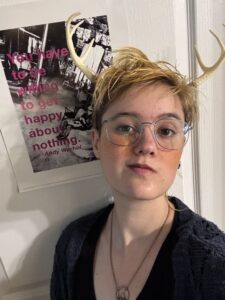 Natanya Norry is a musician, conlanger, and overall magic enthusiast based in Atlanta, GA. They graduated from Georgia Institute of Technology in 2024 with a bachelor’s in Music Technology and a minor in Korean. At the 10th LCC, Natanya presented on Rhapsodaic, a written engelang she created to prioritize emotional specificity over material specificity, and on the design strategy of “divergent translation.” Natanya Norry is a musician, conlanger, and overall magic enthusiast based in Atlanta, GA. They graduated from Georgia Institute of Technology in 2024 with a bachelor’s in Music Technology and a minor in Korean. At the 10th LCC, Natanya presented on Rhapsodaic, a written engelang she created to prioritize emotional specificity over material specificity, and on the design strategy of “divergent translation.”
Outside of conlanging, Natanya composes, sings, produces, and performs music in both English and Toki Pona, and hopes to soon have a spoken conlang developed enough for songwriting. He also writes essays and TTRPGs on itch.io, Substack, and YouTube. Pronouns: they/he/fae/she |
|
| Sat 08:25 S I Sat 16:15 GP I |
Sheldon Cooper | Ten years of Viossa | Viossa is a conpidgin which has been going for approximately ten years and has notable sociolinguistic features such as a unique taboo on translation, various lect groups, and well-recorded diachronic change over time. In this presentation, I discuss the foundations of Viossa, some of the challenges involved in its lifetime, and some of its successes. As accompanying material, I also present samples of written and spoken Viossa in order to showcase its features. |  I am a 28-year old musician and software engineer living in Bethlehem, PA. I am nikomiko on discord. I was there within a week of Viossa’s formation in 2014. I am a 28-year old musician and software engineer living in Bethlehem, PA. I am nikomiko on discord. I was there within a week of Viossa’s formation in 2014. |
|
| Sat 09:10 S I Sat 16:15 GP I |
KGB (Galen Evan Kowalski Buttitta) | The Development of the Caber Logograms | In this presentation, the Caber logograms are discussed from both in- and out-of-universe perspectives, with attention to their development, theory, interface with languages of Íröd, and practical considerations from an artistic standpoint. | KGB—Galen Evan Kowalski Buttitta—graduated with a bachelor’s in linguistics from the University of Oklahoma (class of 2014). His primary conlanging focus is the world of Íröd in his “Twin Aster” setting. He is the creator of the Caber logography, a script with several hundred glyphs, and the languages for which it is used. When he is not working with conlangs or conworlds, he is by day an anti-money laundering compliance analyst and by night a progressive metal drummer. Discord @maninspace. | |
| Sat 11:35 G R | Jú | The Firdic runes: A non-linear writing system (that could be magic) | Firdic is an a posteriori conlang with a heavy focus on linguistically plausible diachronic reconstruction from Proto-Germanic and an additional unknown substrate. Set on the fictional island of Firgaja some 700 km northeast of Orkney, it has developed properties that may be considered unusual for a Germanic language, such as an alternation between infixed and suffixed object pronouns, a complete collapse of the masculine/feminine distinction in the pronominal domain, a differentiated system of grammatical number with categories such as paral and singulative and a semi-grammaticalized hypocoristic system.
The presentation focuses on another feature: Firdic’s non-linear writing system, called the Firdic Runes. Words are represented by composite characters (“runes”), which are made up of components connected by a continuous line. The orientation of this line changes depending on the segments it traverses. It is laid out by the initial letter, progressing downward, rightward or at various oblique angles, with all following segments aligning to it by rotating. The primary direction can subsequently change in various ways based on the sounds contained within the word. As changes apply relative to the incident angle of the line, considerable variation arises across composites with regard to their overall proportions, configuration and character orientation. The result is an ornamental script that starts in the middle of the page and grows outward in directions that are determined by phonology. Even though the language has a rich phonological inventory (36 consonants, 15 monophthongs, 18 diphthongs), the Firdic Rune system rests on a repertoire of only eighteen phonologically underspecified base letters organized in two 3×3 grids based on sonority. Phonological contrasts beyond the contrasts captured in these basic letters are rendered by positional variation and graphetic manipulation. The script also includes a notational system for numbers which is base-20 with a subbase of 5, following the structure of Firdic numerals that is able to represent real numbers up to 999.999 as a single composite character. In this talk, I present the system and its development as well as some determinants of the digraphia that is present on Firgaja, where a Latinate orthography is used alongside the Runes. I describe the division of labor between these two drastically different writing systems, briefly touching upon the use of the Runes in both everyday contexts and in folkloric practices. |
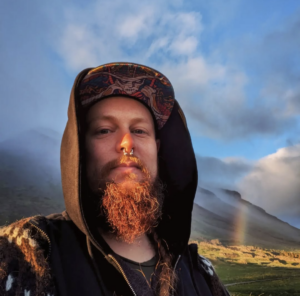 Jú (they/he, @geflissentlich on Instagram, @geflissentlich.bsky.social on BlueSky) is a non-binary linguist living in Berlin. They have been fascinated by languages all their life and have been an avid conlanger since the age of about 10. Firdic is Jú’s most extensive project, which they have been working on for over 20 years and which has taken on an artistic, visual and sometimes musical level in addition to the conlanging side. Jú (they/he, @geflissentlich on Instagram, @geflissentlich.bsky.social on BlueSky) is a non-binary linguist living in Berlin. They have been fascinated by languages all their life and have been an avid conlanger since the age of about 10. Firdic is Jú’s most extensive project, which they have been working on for over 20 years and which has taken on an artistic, visual and sometimes musical level in addition to the conlanging side. |
|
| Sat 08:30 G I | Carl Avlund | The Benefits of Ambiguous Phonological Analysis | Good phonological analysis in naturalistic conlanging is a virtue: The conlanger knows to distinguish their phonemes from their allophones, and to describe well the systems and processes behind these.
As the “all-knowing” creator of a language, the conlanger does nood necessarily need to speculate on the nature of a conlang’s phonology, for they are in a position to simply know what is, in fact, the case, because they made it so: “Let there be a phoneme,” they might say, and there will be a phoneme. “Let the phoneme have the following allophones in the following environments,” and there will be such allophones. But for many, many natural languages in the world, the question of phonological analysis is not so simple: What are, in fact, the primary distinctive features of this phoneme? Could one argue that it is actually in complementary distribution with another sound? Which IPA symbol is most appropriate to represent a particular phoneme with a particular set of features? What should could as a segmental feature and what should count as a suprasegmental feature? These are all questions that come up in the phonological description of natural languages. They often don’t have clear-cut answers, and a naturalistic conlanger could potentially benefit from accepting the existence of ambiguous phonological analyses in their conlangs. In this presentation, Carl Avlund gives examples of ambiguous phonological analyses from natural languages and his own conlangs alike, demonstrating how allowing ambiguity can aid the conlanger in approaching a greater degree of naturalism. |
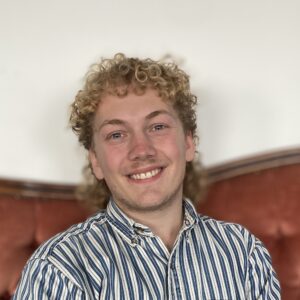 Carl Avlund /ˈkʰa̰ːl ˈaʊlɔn̰/ (commonly found under the name Cawlo in most online spaces) is a student of linguistics at the University of Copenhagen, Denmark. He spends most of his time thinking and dreaming about language, in all its facets, but with a particular interest in typology. Avlund grew up in Lejre on Sjælland, where monuments from the Stone, Bronze, and Viking Age litter the landscape, sparking interest and fascination with all that is ancient, and eventually leading him down the path of dead languages and into linguistics. A deep love of language brought Avlund into conlanging and worldbuilding, which he has pursued as hobbies since 2016. Carl Avlund /ˈkʰa̰ːl ˈaʊlɔn̰/ (commonly found under the name Cawlo in most online spaces) is a student of linguistics at the University of Copenhagen, Denmark. He spends most of his time thinking and dreaming about language, in all its facets, but with a particular interest in typology. Avlund grew up in Lejre on Sjælland, where monuments from the Stone, Bronze, and Viking Age litter the landscape, sparking interest and fascination with all that is ancient, and eventually leading him down the path of dead languages and into linguistics. A deep love of language brought Avlund into conlanging and worldbuilding, which he has pursued as hobbies since 2016. |
|
| Sun 10:20 S R | jan Olipija | Sign Languages of the Toki Pona Community | The Toki Pona community has had many attempts to create a sign languages and systems. These include Signed Toki Pona (STP), Chuff’s Toki Pona Sign Language (TPSL), Luka Pona Sign Language (LPSL), Toki Luka Pona, and Simplified Sign System (SSS).
This presentation will explain a brief history of these different sign languages and systems, and will do a brief comparison. She will also briefly touch on the important socio-cultural context of sign and why having a true sign language is important. |
jan Olipija is a hard of hearing signer of BSL. She works as a Freelance Language Consultant and Support Worker with SignHealth. She studied BSL, Deaf Studies and Linguistics BA(Hons) at York Saint John University. | |
| Sat 15:15 S I | Logan Kearsley | The Three Faces of Omnipredicationality | Omnipredicationality is a unified concept — allowing everything (omni) to be used a predicate — but the languages it describes can implement that concept in very different ways. In this presentation, Logan presents three conlangs and their natural language inspirations which demonstrate two extreme ends of a spectrum of grammatical organization, and the secret third way that one can Verb All The Things. | 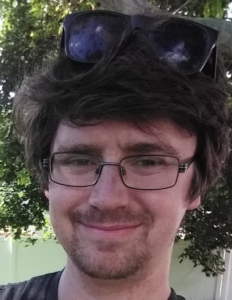 Logan comes from a long line of high school language teachers, and committed teenage rebellion by studying Russian instead of French or German. He has a Master’s degree in Linguistics, 25 years of experience as a serial conlanger, and runs a blog analyzing the use of conlangs in media. Logan comes from a long line of high school language teachers, and committed teenage rebellion by studying Russian instead of French or German. He has a Master’s degree in Linguistics, 25 years of experience as a serial conlanger, and runs a blog analyzing the use of conlangs in media.
gliese1337.blogspot.com |
|
| Sat 16:15 GP I | Logan Kearsley | Tjugem – A Natively Whistled Language | Whistled registers exist naturally for many languages, but they are not languages on their own; rather, they are communication technologies, like writing or Morse code, and like other secondary representations of speech, they omit a lot that is present in the primary modality. The question arises, then: what might a language look like whose primary phonetic medium is whistling? How would its phonology adapt to this unnatural modality? Tjugem is one attempt to answer this question. |  Logan comes from a long line of high school language teachers, and committed teenage rebellion by studying Russian instead of French or German. He has a Master’s degree in Linguistics, 25 years of experience as a serial conlanger, and runs a blog analyzing the use of conlangs in media. Logan comes from a long line of high school language teachers, and committed teenage rebellion by studying Russian instead of French or German. He has a Master’s degree in Linguistics, 25 years of experience as a serial conlanger, and runs a blog analyzing the use of conlangs in media.
gliese1337.blogspot.com |
|
| Sun 14:30 S I | Robin Townsend Lynn Van Hauwe |
Toaq: A parseable human language | Toaq is a loglang, carefully constructed to be naturalistic yet free of syntactic ambiguity. Its parser, Kuna, is a computer program synthesizing ideas from many corners of the field of natural language semantics. It can translate Toaq sentences into syntax trees in the tradition of generative grammar, and annotate them with semantic expressions. We showcase how Toaq lends itself to “monoparsing”, demonstrate Kuna’s capabilities, and discuss some more recent ideas in the field of semantics. | 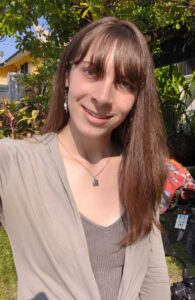 Robin Townsend: I’m a speaker of Toaq. I stick to a small corner of the conlanging world, but I’m very passionate about semantics and making computers interact with language. You can find more about me and my contact info at robin.town; Discord @robintown. Robin Townsend: I’m a speaker of Toaq. I stick to a small corner of the conlanging world, but I’m very passionate about semantics and making computers interact with language. You can find more about me and my contact info at robin.town; Discord @robintown.
Lynn Van Hauwe: I’m a conlang speaker and programmer from Antwerp, Belgium. My Toaq name is Láqme (nháo/hóq), but in the boring outside world, I’m found at lynn.github.io |
|
| Sat 11:05 G I Sat 16:15 GP I |
Magda Kitano | Toki Pona and Japanese: Similarities and Challenges | Toki Pona is designed to be easily acquired by and used between people with linguistic backgrounds from all around the world. Phonology is controlled against the existence of minimal pairs, and word roots come from a wide range of languages. Japanese, however, is particularly close to Toki Pona not only in terms of phonology but also in grammar. Based on experience teaching Toki Pona to university students in Japan for three years, this presentation covers the unique challenges of learning Toki Pona from this particular background.
Several aspects of Toki Pona grammar are much closer to Japanese than English grammar is. Sentences without verbs and the usage of particles are the most obvious. One example is a particle (wo in Japanese and e in Toki Pona) being used to indicate a direct object, although the word order and placement within a sentence are different. Information-seeking interrogative sentences are also constructed similarly in the two languages; starting with an affirmative sentence, a question word (seme in Toki Pona and words such as nani or dare in Japanese) is placed in the location of the information that you want to know. In other words, there is no inversion or other change in word order for interrogatives. Most striking, though, is the similarity in usage of the particle la in signaling context in Toki Pona with the wa of Japanese in certain cases. While these similarities should make Toki Pona easy for learners in Japan, the presenter has found this not to be the case. A tendency to expect any foreign language to be similar to English was observed, and this expectation would override illustrations of how learners can simply utilize grammatical structures they are using daily in their native language. Other difficulties include the differences in what can be omitted in an utterance. Toki Pona and Japanese are both high context languages, but what doesn’t need to be said does not coincide. For example, the subject and even the direct object are often omitted in Japanese, but vagueness in Toki Pona comes rather from content words that have a wide variety of possible meanings. The presentation concludes that learners from a Japanese language background would benefit from example sentences and lessons that are tailored specifically to their needs rather than utilizing lessons translated from other languages. |
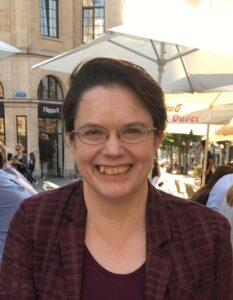 Magda Kitano is an associate professor in the International Studies Faculty of Bunkyo University in Tokyo, Japan. She has been writing English language textbooks for the national Japanese curriculum for over 25 years. Her research interests include vocabulary, constructed languages, extensive reading, and textbook analysis. First learning Toki Pona in 2022, she has been building up a Toki Pona community in Japan through campus activities, videos, SNS, and a web site (studentloungemagda.jp). She posts in Toki Pona on BlueSky (@magmakit.bsky.social), Discord @janmaka. Magda Kitano is an associate professor in the International Studies Faculty of Bunkyo University in Tokyo, Japan. She has been writing English language textbooks for the national Japanese curriculum for over 25 years. Her research interests include vocabulary, constructed languages, extensive reading, and textbook analysis. First learning Toki Pona in 2022, she has been building up a Toki Pona community in Japan through campus activities, videos, SNS, and a web site (studentloungemagda.jp). She posts in Toki Pona on BlueSky (@magmakit.bsky.social), Discord @janmaka. |
|
| Sun 11:30 G R | Joey Windsor | Using Non-Romanized Orthographies | Frequently, many of us use at least two systems for encoding our conlangs, IPA and a Romanization, and we may also encode our language(s) with a conscript. Besides the ease of use for many of us who use a Roman alphabet in our day-to-day interactions, why should we stick with encoding our conlangs in Romanization?
In this presentation, I discuss different writing systems available us to adapt for our conlangs, and some of the pros, cons, and ethical considerations I have encountered with using different real-world orthographies. I primarily focus on adapting Middle Egyptian Hieroglyphics for use in encoding my Dal’a conlang: Why I chose this system, what I had to do to make the system work for my conlang, purposeful departures from the original system, and what on-going challenges I face working with these glyphs. Additionally, I discuss a personal ethical consideration around using Cree Syllabics for encoding a conlang. These considerations come from a point-of-view of someone who has worked with Indigenous communities in Canada, and I ask open questions as to whether using an Indigenous writing system is cultural appropriation (any more or less than any other culturally-linked system), and if in today’s culture it is okay to use a culturally-linked orthography, even if it is available in Unicode. |
 Joseph W. Windsor (Joey; he/him) received his PhD in Linguistics in 2017 for his work on the syntax-phonology interface, primarily focusing on Irish and Blackfoot languages. After receiving his PhD, Joey completed a two-year post-doc in Medicine and Community Health Sciences where he currently works as a Knowledge Translator, employing his knowledge of Linguistics to help make medical information accessible to a wide variety of stakeholders without watering down the science. Joseph W. Windsor (Joey; he/him) received his PhD in Linguistics in 2017 for his work on the syntax-phonology interface, primarily focusing on Irish and Blackfoot languages. After receiving his PhD, Joey completed a two-year post-doc in Medicine and Community Health Sciences where he currently works as a Knowledge Translator, employing his knowledge of Linguistics to help make medical information accessible to a wide variety of stakeholders without watering down the science.
As a conlanger, Joey was President of the LCS from 2018–2024, where one of his primary foci was increasing acceptance of conlangs in academic settings. His interests are in creating naturalistic languages for use in fantasy role-playing games, and he has created more than 20 languages to date, both for himself and for clients in a professional setting. He is also a Klingonist, and has published on the second language stress acquisition of Klingon in the Journal of the Canadian Linguistic Association. The language he is most frequently working on now is Dal’a, a language for a Dungeons & Dragons setting that features retroflex consonants, VSO order, post-positions, and a writing system based on Middle Egyptian hieroglyphics. |
Open meetups
| time | organizer(s) | title | abstract | bio(s) |
|---|---|---|---|---|
| Fri 09:00 G/A/U | Pre-conference social meetup | Meet up with other LCC11 attendees before the program officially begins.
In person: meet up at the main LCC11 venue (H.J. Patterson rooms 2124 & 2113), get food at the Stamp Student Union, relax in the HJP Atrium. Come any time between 09:00 and 13:30 — at 14:00, setup begins in Jiménez 1205, and the H.J. Patterson rooms will be locked. Note: this will not be streamed, recorded, or interpreted/captioned. Online: go to the LCS Discord #lcc11-attendees-voice channel (for registered attendees). |
||
| Sun 07:30 T I | Zie Weaver Isabel Gardener |
Conlang Morning Prayers (Christian) | Join us on Sunday, April 13th for a non-denominational Christian prayer service completely in conlangs. Programs are provided with English translations, however the service itself will primarily be in Esperanto with some hymns, readings, and prayers in other conlangs such as Lojban or Toki Pona. Everyone is welcome.
If you’re interested in coming to the Christian prayer meetup, please fill out this form. If you would like to contribute hymns, prayers, or readings, please use this form. |
 Zie Weaver is a confirmed Lutheran in the ELCA, and has been conlanging since she was young. She speaks Lojban, and a little Toaq and Esperanto in addition to varying natlangs. Discord: @zearen Zie Weaver is a confirmed Lutheran in the ELCA, and has been conlanging since she was young. She speaks Lojban, and a little Toaq and Esperanto in addition to varying natlangs. Discord: @zearen
Isabel Gardener is an accomplished Lojbanist that writes sad songs in made up languages (@NoiseAndBells). She was raised in the LDS (Mormon) church, and converted to Anglicanism as an adult. Discord: @noiseandbells |
| Sat 15:15 T I | Sai | Meetup for ASL signers |  Sai is an ASL signer conlanger. Sai is an ASL signer conlanger. |
|
| Sun 10:20 T I | Sai | Off-the-record meetup for pro conlangers | This is an in-person-only meetup for pro conlangers, i.e. conlangers who have (at least once) created a language as a job, to talk shop, share experiences, and discuss prices, techniques, customer & public relations, marketing, unionization, etc. It will not be recorded or streamed in any way.
Although this meetup is not private (i.e. the identities of people attending are not confidential), it is strictly off-the-record. All attendees must promise not to disclose any identifiable information learned at the meetup without the explicit individual consent of the source. Sai will be in attendance in official capacity on behalf of the LCS. |
 Sai negotiated the original contract with HBO for Dothraki on Game of Thrones, and gave a talk on conlanging and US intellectual property law at LCC6. Although not a lawyer, they have substantial legal experience, including an externship for a judge on the U.S. Court of Appeals for the Ninth Circuit; winning decisions in contested matters before the U.S. District Court D.C., Federal Election Commission, Postal Regulatory Commission, and small claims courts; contributing to research published in the European Journal of Law and Economics; co-authoring Privacy Coalition letters; and getting changes to the US Federal Rules of Appellate Procedure adopted by the Administrative Office of U.S. Courts and the U.S. Supreme Court. Sai negotiated the original contract with HBO for Dothraki on Game of Thrones, and gave a talk on conlanging and US intellectual property law at LCC6. Although not a lawyer, they have substantial legal experience, including an externship for a judge on the U.S. Court of Appeals for the Ninth Circuit; winning decisions in contested matters before the U.S. District Court D.C., Federal Election Commission, Postal Regulatory Commission, and small claims courts; contributing to research published in the European Journal of Law and Economics; co-authoring Privacy Coalition letters; and getting changes to the US Federal Rules of Appellate Procedure adopted by the Administrative Office of U.S. Courts and the U.S. Supreme Court.
Sai is the LCS’ Parliamentarian and Board Chair. They handle all LCS legal matters (short of actually acting as a lawyer), direct LCS lawyers, manage LCS contracts, and are in charge of multiple ongoing legal issues on behalf of the LCS. As Sai is not a lawyer, they cannot give you any legal advice or represent you in court. However, they can give information, and may be able to help you address any conlanging-related legal issues you have (on behalf of the LCS). Please email them at legal@nulls.ai CC lcs@nullconlang.org if you have any such concerns. |
Private meetups
These meetups will be only in person, and will not be recorded or streamed. They will be held at a time and place disclosed only to participants in that meetup. To be included, you must sign up on the separate registration form which is only accessible by Sai (who is autistish, disabled, plural, queer, & non-binary), to confirm that you are a member of the affinity group in order to be told where and when its meetup will be held.
Outing other meetup participants in any way (including by taking photos or video of the meetup) is strictly prohibited, and may result in being immediately ejected from LCC11 without a refund.
| title |
|---|
| Private social meetup for autistic conlangers |
| Private social meetup for disabled conlangers |
| Private social meetup for plural conlangers |
| Private social meetup for queer conlangers |
| Private social meetup for trans & non-binary conlangers |
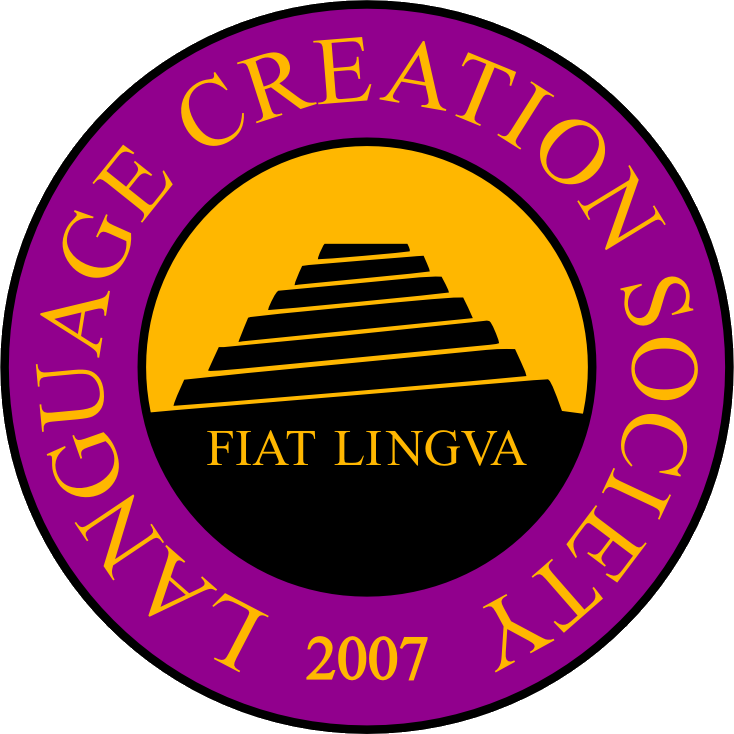
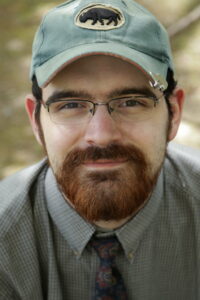 Daniel Swanson is the prose ring master.
Daniel Swanson is the prose ring master.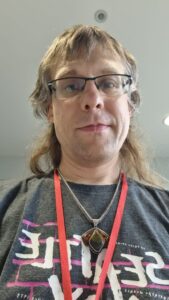
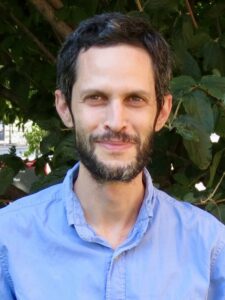
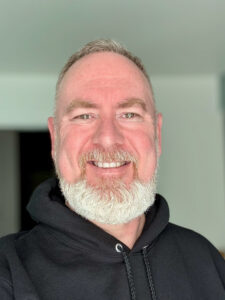 Britton Watkins (he/him, 58) is a native of South Carolina now residing in the Palm Springs area of Southern California after 8 years living and working in Japan in his 20’s and 30’s and 20 years in the San Francisco Bay Area. He is a polyglot and director of the documentary,
Britton Watkins (he/him, 58) is a native of South Carolina now residing in the Palm Springs area of Southern California after 8 years living and working in Japan in his 20’s and 30’s and 20 years in the San Francisco Bay Area. He is a polyglot and director of the documentary, 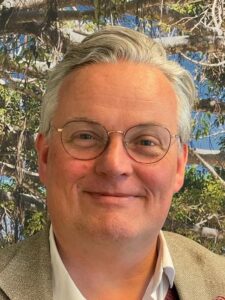 Jan van Steenbergen (54) is a Dutch polyglot and linguist from the Netherlands. He works for the Dutch government and, additionally, as a freelance translator/interpreter Polish and Dutch. He published articles about interlinguistics and is the author of several conlangs himself. His oeuvre includes the North Slavic language Vozgian (1996) and the Polish-based Romance language Wenedyk (2002), both part of the alternative history project Ill Bethisad; Interslavic (2006), a zonal language for Slavic speakers with a community currently consisting of ca. 30,000 people; and Boksirit (2025), created for the Indian horror film Bokshi, which premiered in January 2025 during the International Film Festival in Rotterdam. He is a member of the Volapük Academy and moderator of the Volapük Wikipedia and the (currently incubated) Interslavic Wikipedia project. During the years 2016–2024 he was Vice President of the LCS.
Jan van Steenbergen (54) is a Dutch polyglot and linguist from the Netherlands. He works for the Dutch government and, additionally, as a freelance translator/interpreter Polish and Dutch. He published articles about interlinguistics and is the author of several conlangs himself. His oeuvre includes the North Slavic language Vozgian (1996) and the Polish-based Romance language Wenedyk (2002), both part of the alternative history project Ill Bethisad; Interslavic (2006), a zonal language for Slavic speakers with a community currently consisting of ca. 30,000 people; and Boksirit (2025), created for the Indian horror film Bokshi, which premiered in January 2025 during the International Film Festival in Rotterdam. He is a member of the Volapük Academy and moderator of the Volapük Wikipedia and the (currently incubated) Interslavic Wikipedia project. During the years 2016–2024 he was Vice President of the LCS.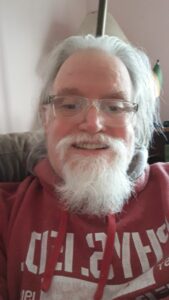 Jim received a BA in French from Hofstra University in 1974 and an MS in Metaphysics from the American Institute of Holistic Theology in 1998. He is a published poet, Eden’s Day (2008), and author of the published novel Circle of the Lantern (2015), which features five of his conlangs. He has been involved in language construction since 1995 with the birth of his first conlang, Itlani (then known as Druni). Although Itlani is his first and foremost love, since that time he has been developing Semerian (Pomolito), Djiran (Ijira), Djanari (Nordsh) and Lastulani (Lastig Klendum), the other languages spoken on the planet Itlán. One further language project, Kreshem (Losi e Kreshem), is also under development. His primary interest in language construction is from an aesthetic and artistic perspective.
Jim received a BA in French from Hofstra University in 1974 and an MS in Metaphysics from the American Institute of Holistic Theology in 1998. He is a published poet, Eden’s Day (2008), and author of the published novel Circle of the Lantern (2015), which features five of his conlangs. He has been involved in language construction since 1995 with the birth of his first conlang, Itlani (then known as Druni). Although Itlani is his first and foremost love, since that time he has been developing Semerian (Pomolito), Djiran (Ijira), Djanari (Nordsh) and Lastulani (Lastig Klendum), the other languages spoken on the planet Itlán. One further language project, Kreshem (Losi e Kreshem), is also under development. His primary interest in language construction is from an aesthetic and artistic perspective.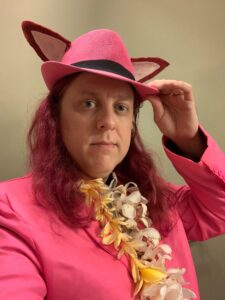 Eric Barker (he/him) has a degree in technology and electronic music composition. During the day, he works as an audio engineer and specializes in audio and video recording, editing, videography, graphic design, and 3D modeling. He is also a music producer and a keyboardist, playing in several bands of varying genres (from prog rock to Klezmer). His interests are wide and include science, acoustics, design, technology, worldbuilding, programming, and cooking. He also loves cute animals. He has worked with Margaret on conlang-adjacent projects for many years now, and is excited to perform the music of Aeniith.
Eric Barker (he/him) has a degree in technology and electronic music composition. During the day, he works as an audio engineer and specializes in audio and video recording, editing, videography, graphic design, and 3D modeling. He is also a music producer and a keyboardist, playing in several bands of varying genres (from prog rock to Klezmer). His interests are wide and include science, acoustics, design, technology, worldbuilding, programming, and cooking. He also loves cute animals. He has worked with Margaret on conlang-adjacent projects for many years now, and is excited to perform the music of Aeniith.